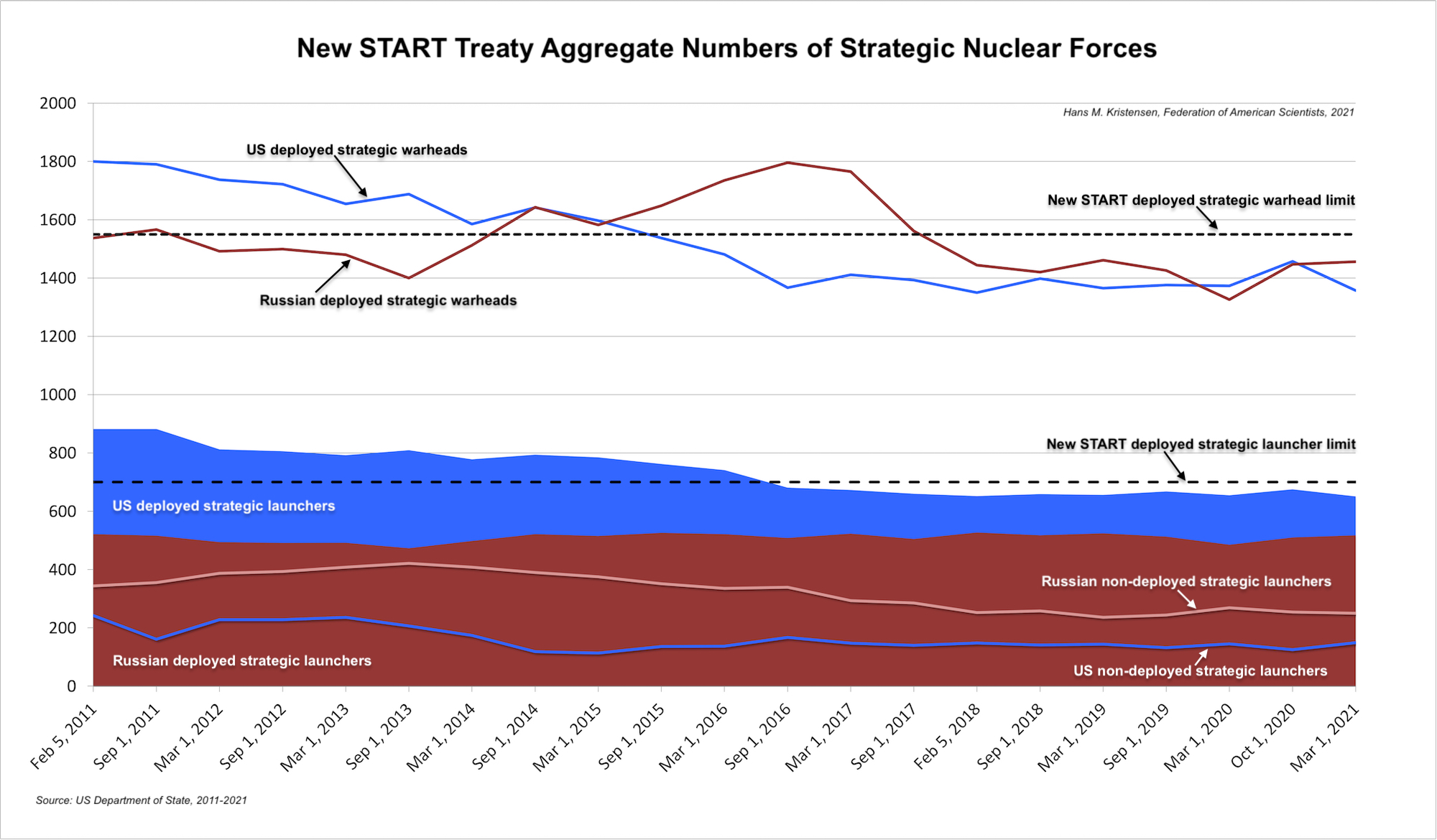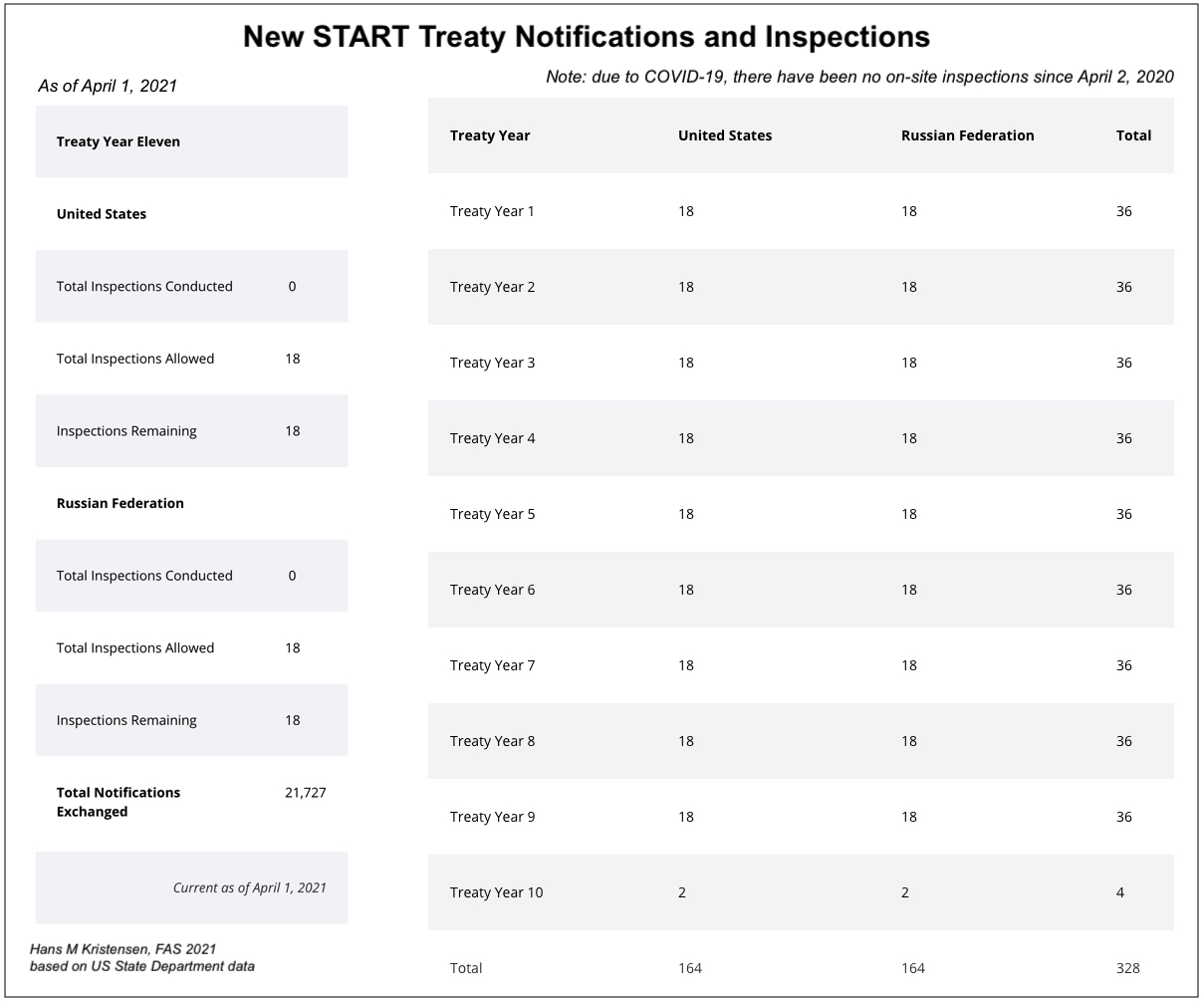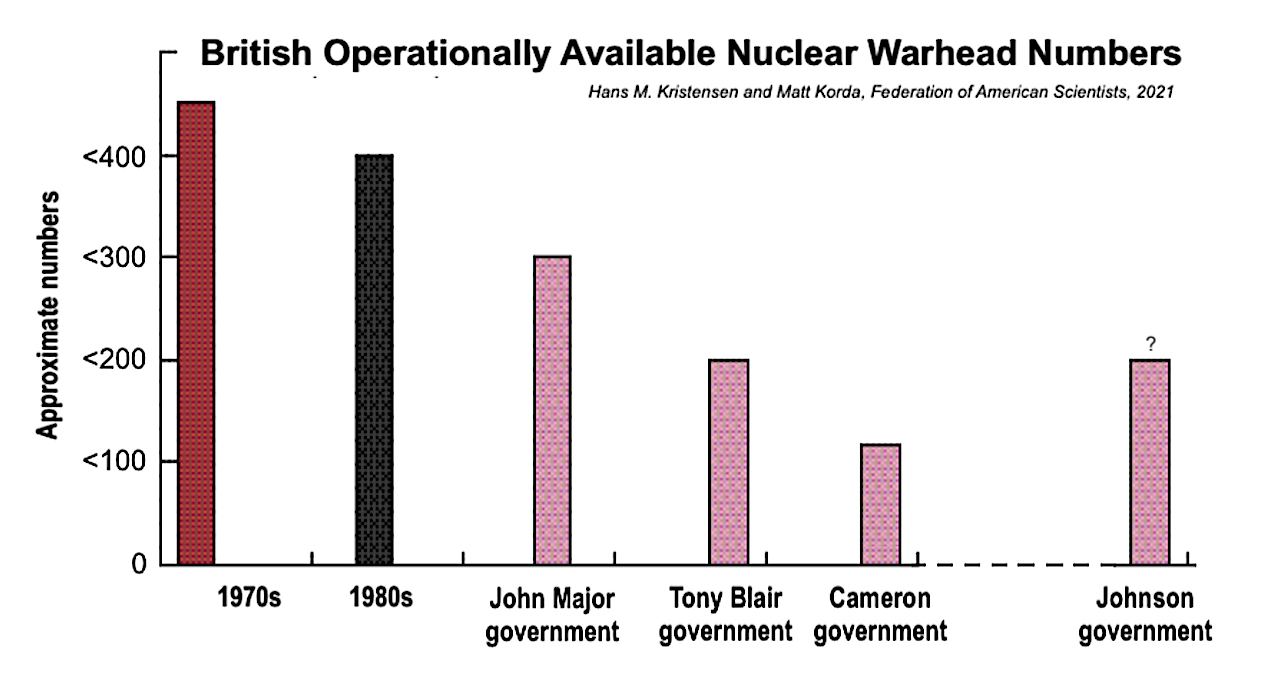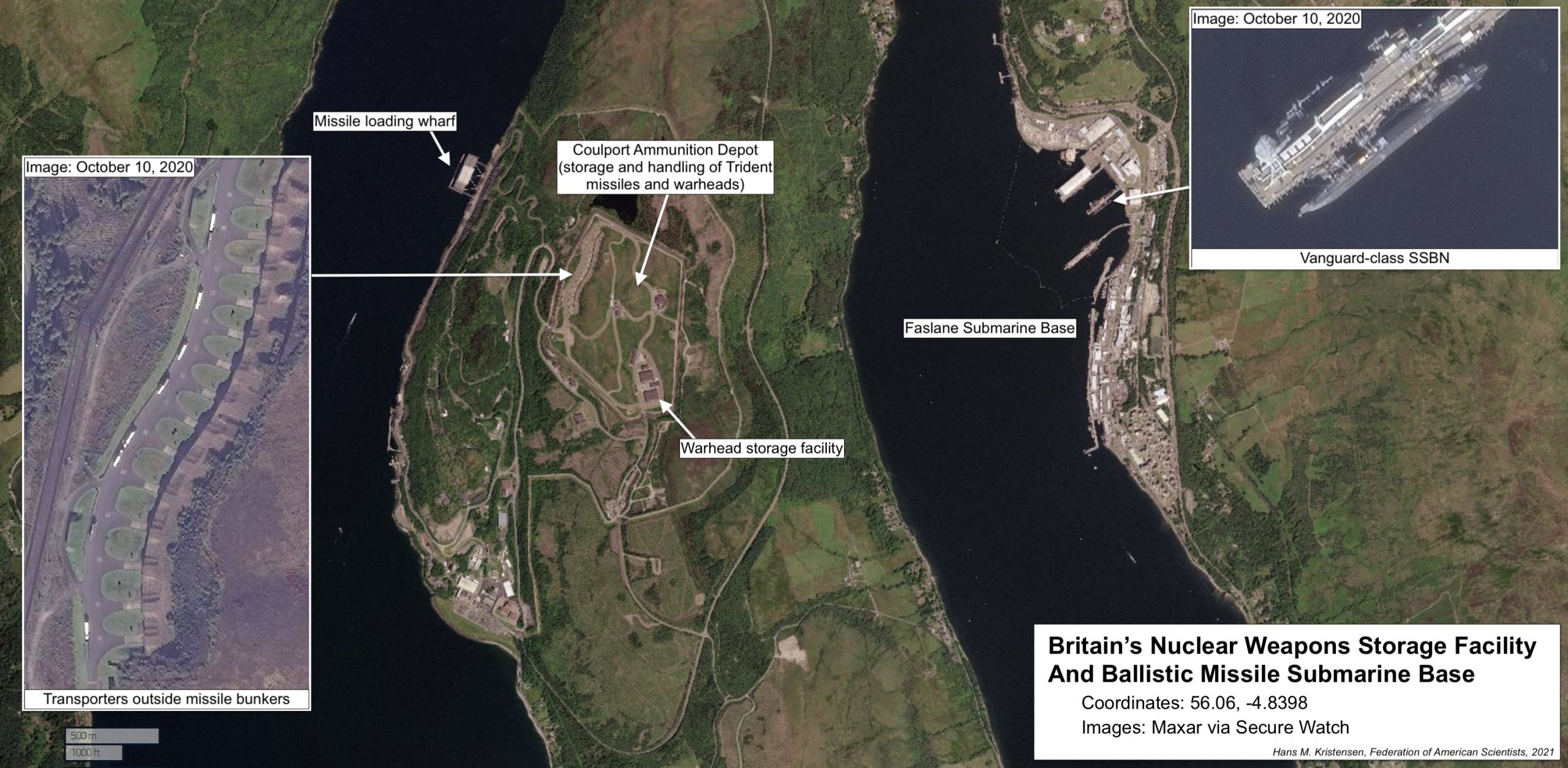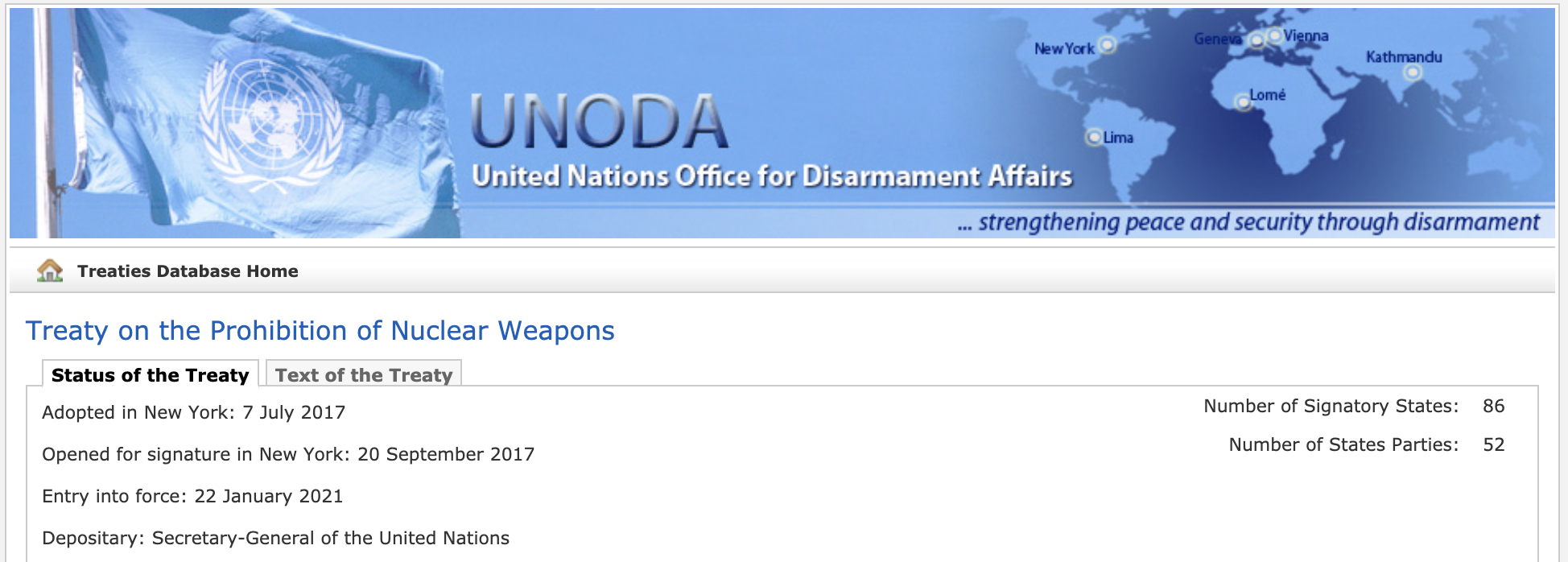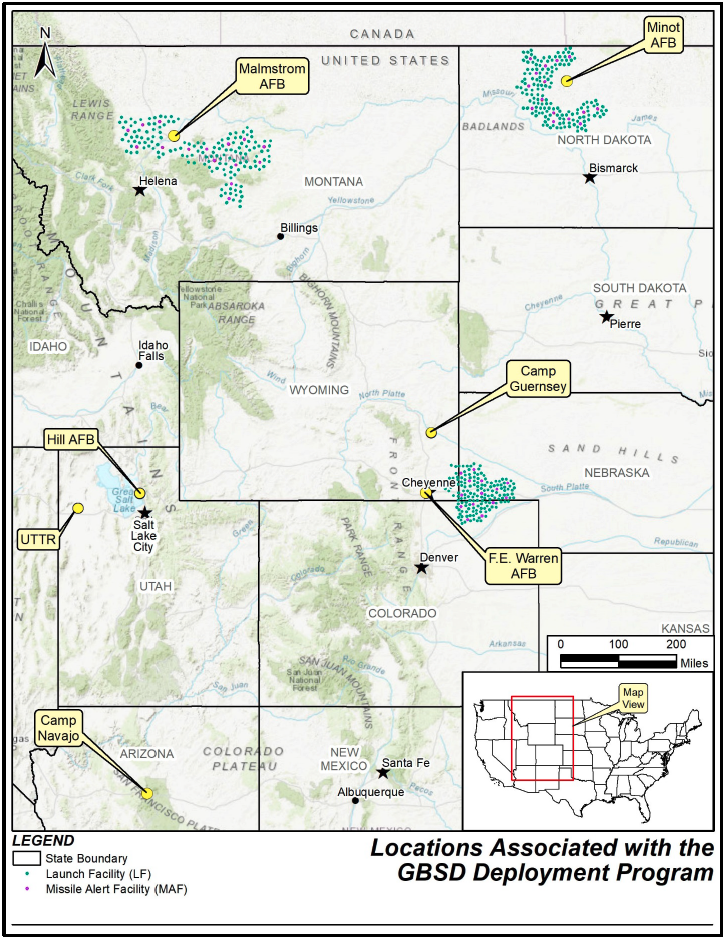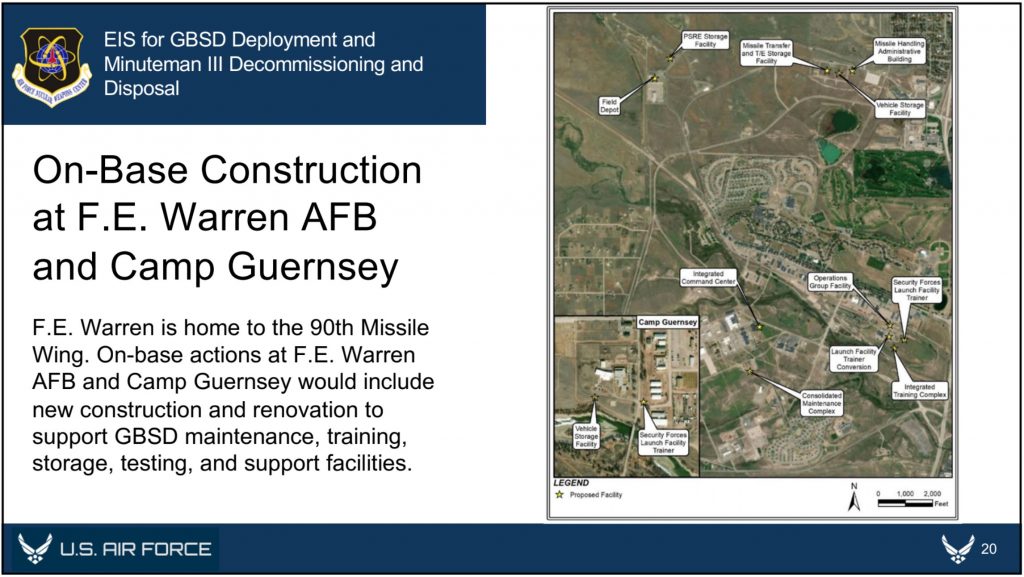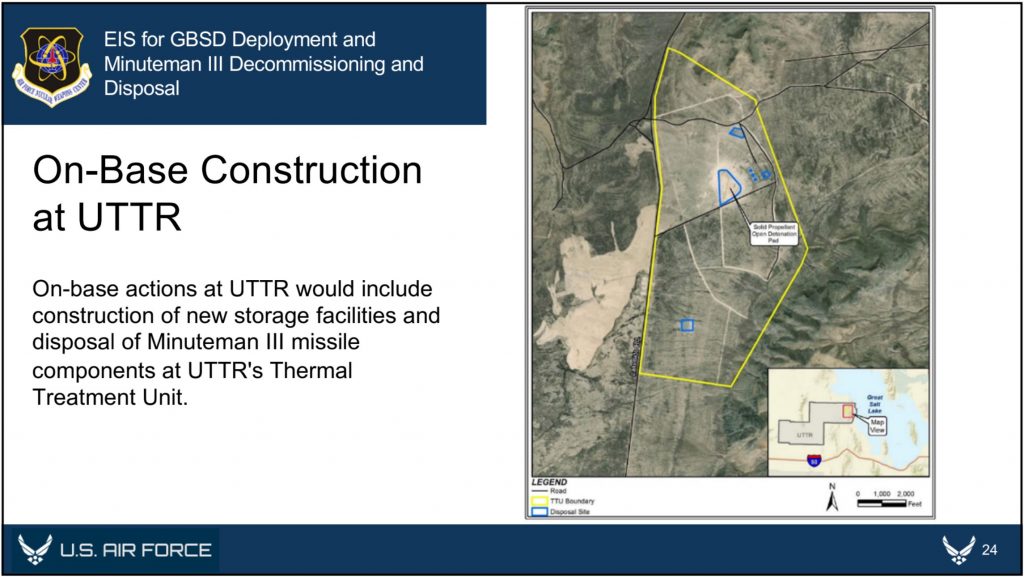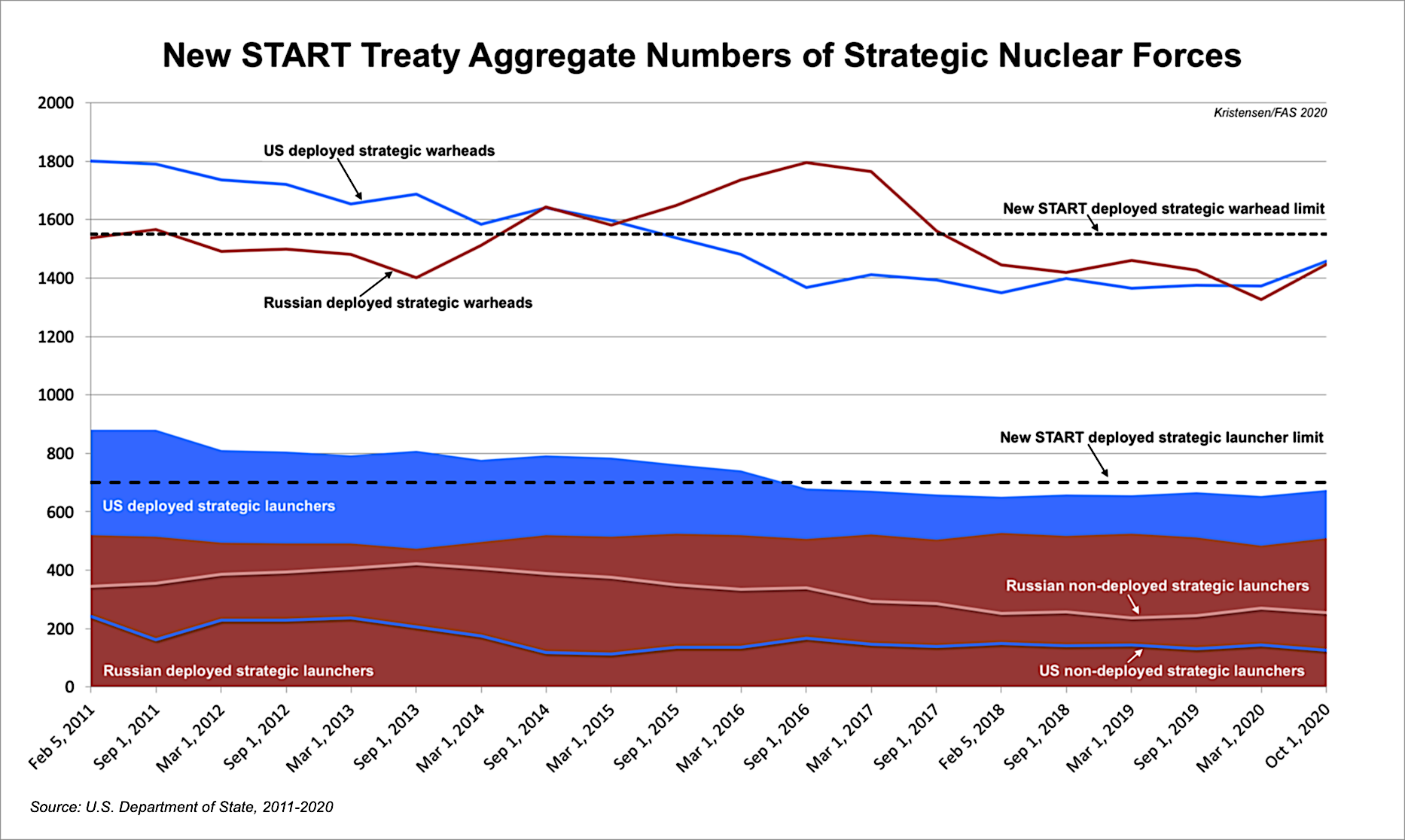Flying Under The Radar: A Missile Accident in South Asia
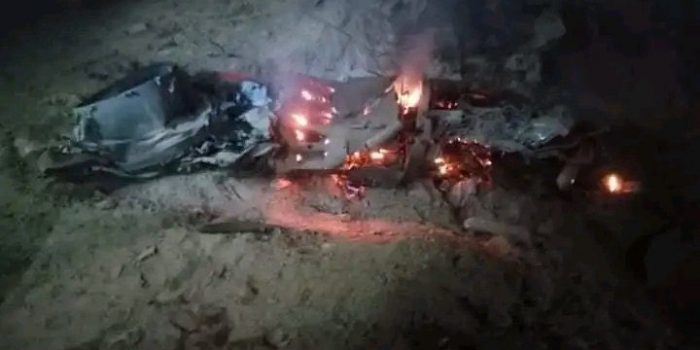
A crashed Indian missile inside Pakistani territory. Image: Pakistan Air Force.
With all eyes turned towards Ukraine these past weeks, it was easy to miss what was almost certainly a historical first: a nuclear-armed state accidentally launching a missile at another nuclear-armed state.*
On the evening of March 9th, during what India subsequently called “routine maintenance and inspection,” a missile was accidentally launched into the territory of Pakistan and impacted near the town of Mian Channu, slightly more than 100 kilometers west of the India-Pakistan border.
Because much of the world’s attention has understandably been focused on Eastern Europe, this story is not getting the attention that it deserves. However, it warrants very serious scrutiny––not only due to the bizarre nature of the accident itself, but also because both India’s and Pakistan’s reactions to the incident reveal that crisis stability between South Asia’s two nuclear rivals may be much less stable than previously believed.
The Incident
Using official statements and open-source clues, it is possible to piece together a relatively complete picture of what took place on the evening of March 9th.
At 18:43:43 Pakistan Standard Time (19:13:43 India Standard Time), the Pakistan Air Force picked up a “high-speed flying object” 104 kilometers inside Indian territory, near Sirsa, in the state of Haryana. According Air Vice Marshal Tariq Zia––the Director General Public Relations for the Pakistan Air Force––the object traveled in a southwesterly direction at a speed between Mach 2.5 and Mach 3. After traveling between 70 and 80 kilometers, the object turned northwest and crossed the India-Pakistan border at 18:46:45 PKT. The object then continued on the same northwesterly trajectory until it crashed near the Pakistani town of Mian Channu at 18:50:29 PKT.
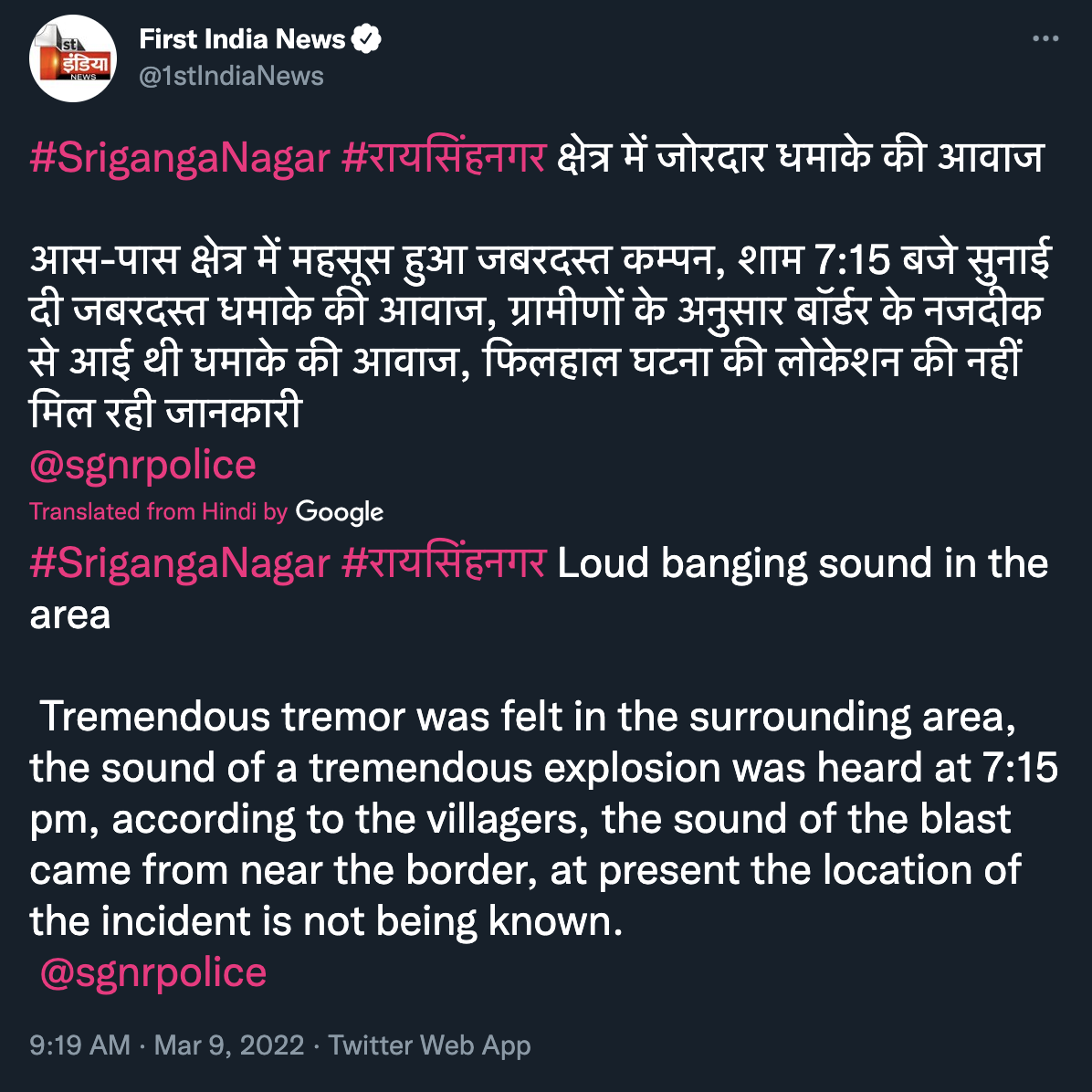
Tweet from @1stIndiaNews indicating that a “tremendous explosion” was heard at approximately 19:15 IST at the city of Sri Ganganagar near the India-Pakistan border. This time and location adds a data point to interpreting the flight path of the missile.
According to Pakistani military officials in a March 10th press conference, 3 minutes and 46 seconds of the object’s total flight time of 6 minutes and 46 seconds were within Pakistani airspace, and the total distance traveled inside of Pakistan was 124 kilometers.

Annotated map of the missile’s flight path provided by Pakistani military officials to media on 10 March 2022.
In a press conference, Pakistani military officials stated that the object was “certainly unarmed” and that no one was injured, although noted that it damaged “civilian property.”
Although the crash site has not been confirmed and official photos include very few useful visual signatures, observation of local civilian social media activity indicates that a likely candidate is the Bakhshu Makhan Hotel, just outside of Mian Channu (30°27’6.40″N, 72°24’10.87″E). One video of the crash site posted to Twitter includes a shot of a uniquely-colored blue building with a white setback roof on the other side of a divided highway. At least two vertical poles can be seen on the roof of the building. All of these signatures appear to match those included in images of the Bakhshu Makhan Hotel in Google Images.
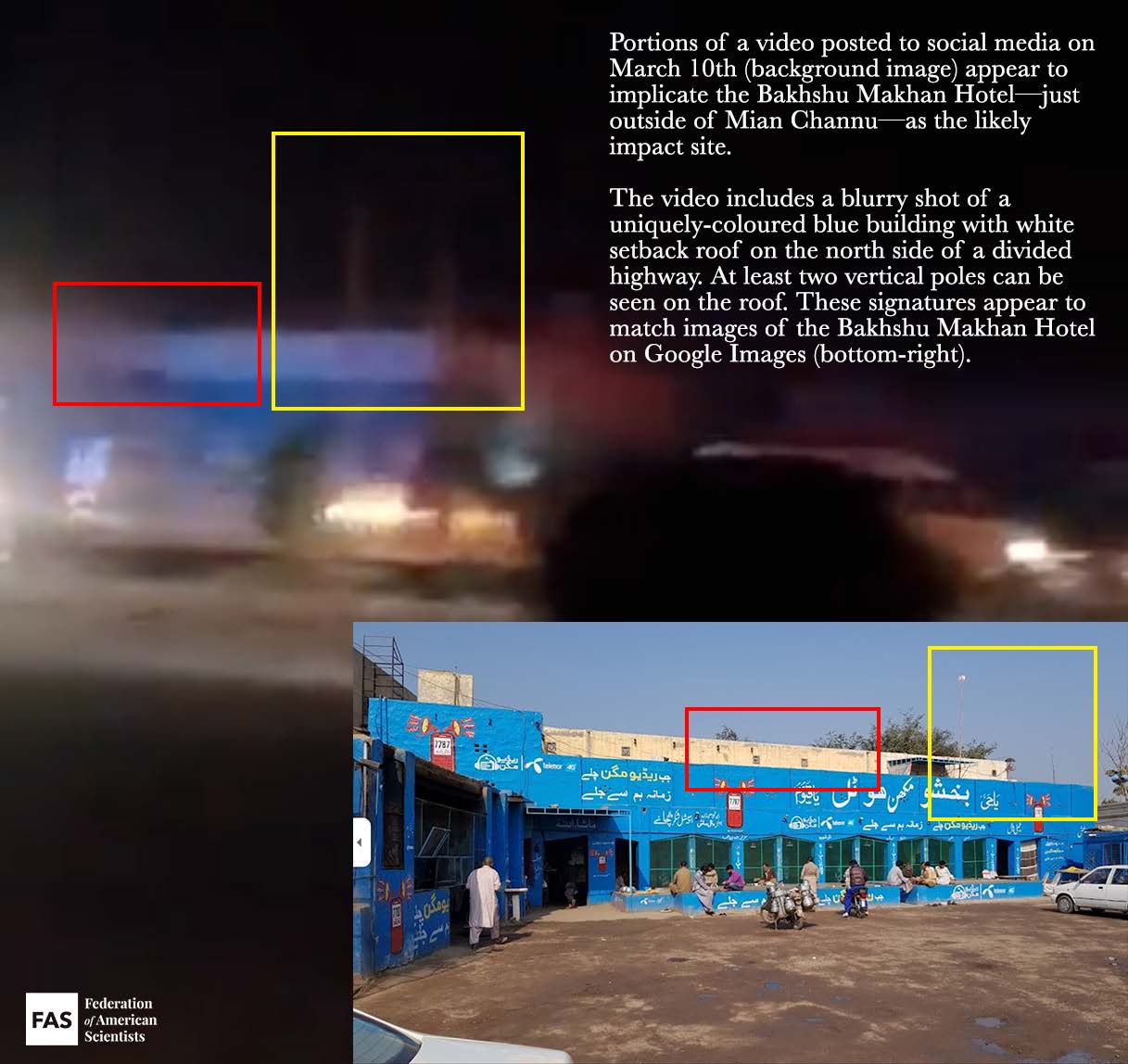
The video’s caption suggests that the object that crashed was an “army aviation aircraft drone;” however, Pakistani military officials subsequently reported that the object was an Indian missile. Neither Pakistan nor India has publicly confirmed what type of missile it was; however, in a March 10th press conference, Pakistani military officials stated that “we can so far deduce that it was a supersonic missile––an unknown missile––and it was launched from the ground, so it was a surface-to-surface missile.”
This statement, in addition to photos of the debris and other official details relating to range, speed, altitude, and flight time of the object, suggest that it was very likely a BrahMos cruise missile.
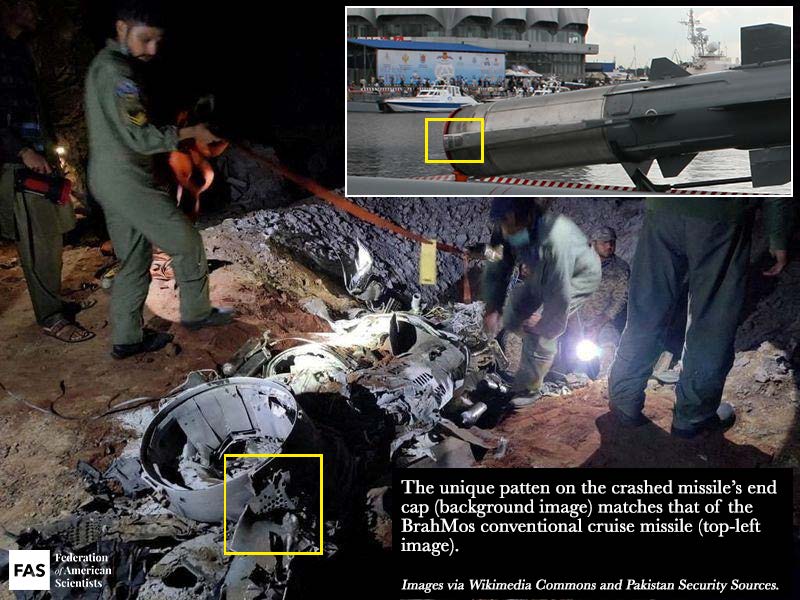
BrahMos is a ramjet-powered, supersonic cruise missile co-developed with Russia, that can be launched from land, sea, and air platforms and can travel at a speed of approximately March 2.8. The US National Air and Space Intelligence Centre (NASIC) suggested that an earlier version of BrahMos had a range of “less than 300” kilometers, but the Indian Ministry of Defence recently announced on 20 January 2022 that it had extended the BrahMos’ range, with defence sources saying that the missile could now travel over 500 kilometres. The reported speed of the “high-speed flying object,” as well as the distance traveled, matches the publicly-known capabilities of the BrahMos cruise missile.
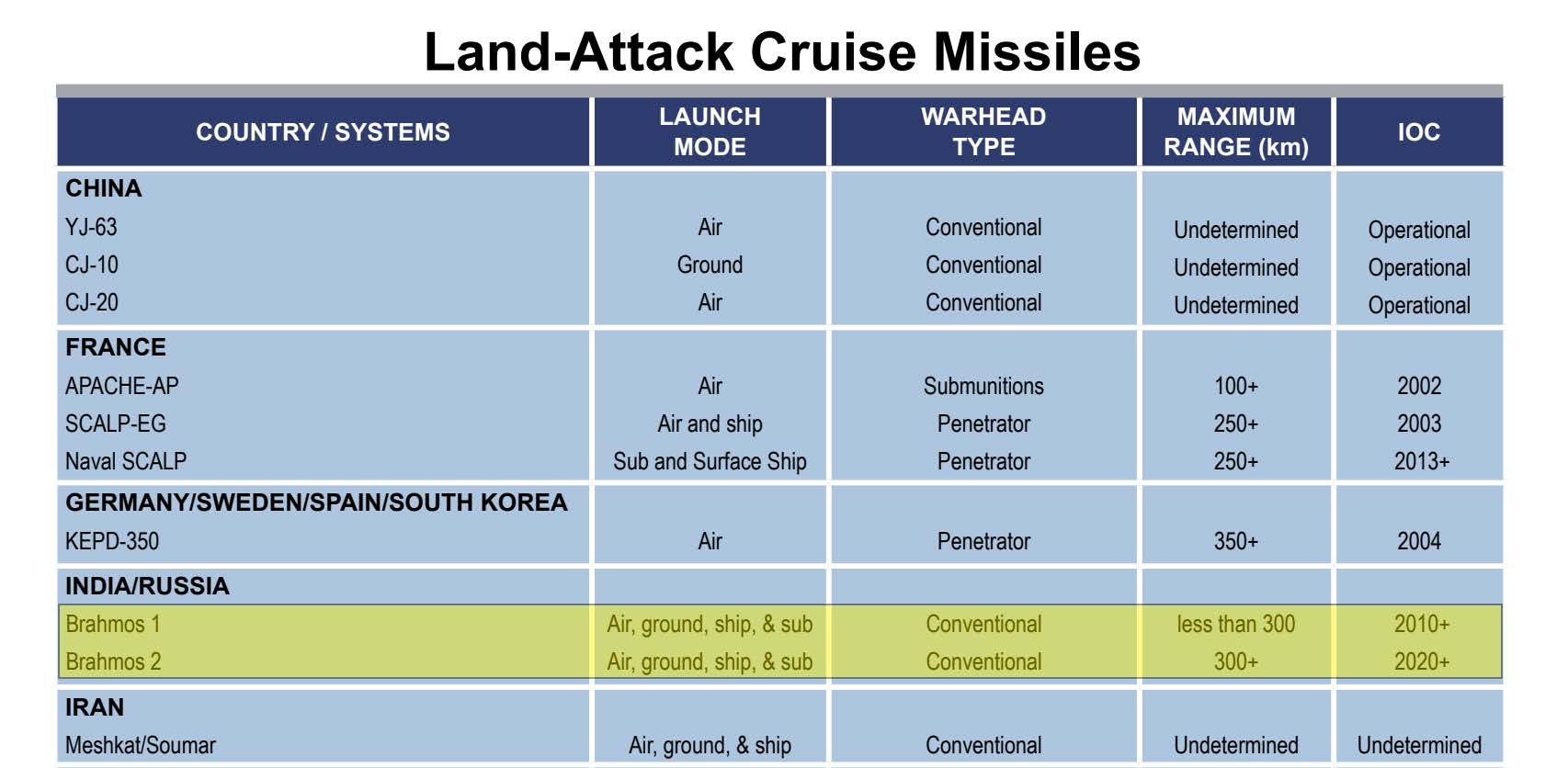
The National Air and Space Intelligence Center’s 2017 Ballistic and Cruise Missile report lists two versions of the BrahMos missile as “conventional.”
Although many Indian media outlets often describe the BrahMos as a nuclear or dual-capable system, NASIC lists it as “conventional,” and there is no public evidence to indicate that the missile can carry nuclear weapons.
India has launched a Court of Inquiry to determine how the incident occurred; however, the Indian government has otherwise remained tight-lipped on details. In the absence of official statements, small snippets have trickled out through Indian and Pakistani media sources––prompting several questions that still need answers.
How did the missile get “accidentally” launched?
According to the Times of India, an audit was being conducted by the Indian Air Force’s Directorate of Air Staff Inspection at the time of the launch. As part of that audit, or possibly as part of a separate exercise, it appears that target coordinates––including mid-flight waypoints––were fed into the missile’s guidance system. According to Indian defence sources, in order to launch the BrahMos, the missile’s mechanical and software safety locks would also have had to be bypassed and the launch codes would have had to be entered into the system.
The BrahMos does not appear to have a self-destruct mechanism. As a result, once the missile was launched, there was no way to abort.
Given that defence sources indicate that the missile “was certainly not meant to be launched,” it still remains unclear whether the launch was due to human or technical error. On March 11th, in its first public statement about the incident, the Indian government stated that “a technical malfunction led to the accidental firing of a missile.” However, since the formal convening of a Court of Inquiry, the government has since changed its rhetoric, with Indian officials stating that “the accidental firing took place because of human error. That’s what has emerged at this stage of the inquiry. There were possible lapses on the part of a Group Captain and a few others.” Tribute India reports that there are currently four individuals under investigation.
While this is certainly a plausible explanation for the incident, it is also worth noting that the Indian government would be financially incentivized to emphasize the human error narrative over a technical malfunction narrative. On January 28th, India concluded a $374.96 million deal with the Philippines to export the BrahMos––a deal which amounts to the country’s largest defence export contract. Additional BrahMos exports will be crucial for India to meet its ambitious defence export targets by 2025, and the negative publicity associated with a possible BrahMos technical malfunction could significantly hinder that goal.
Did Pakistan track the missile correctly?
In a press conference on March 10th, Pakistani military officials noted that Pakistan’s “actions, response, everything…it was perfect. We detected it on time, and we took care of it.” However, Indian military officials have publicly disputed Pakistan’s interpretation of the missile’s flight path. Pakistan announced on March 10th that the missile was picked up near Sirsa; however, Indian officials subsequently stated that the missile was launched from a location near Ambala Air Force Station, nearly 175 kilometers away. India’s explanation is likely to be more accurate, given that there is no known BrahMos base near Sirsa, but there is one near Ambala (h/t @tinfoil_globe). Indian defence sources have also suggested that the map of the missile’s perceived trajectory that the Pakistani military released on March 10th was incorrect.
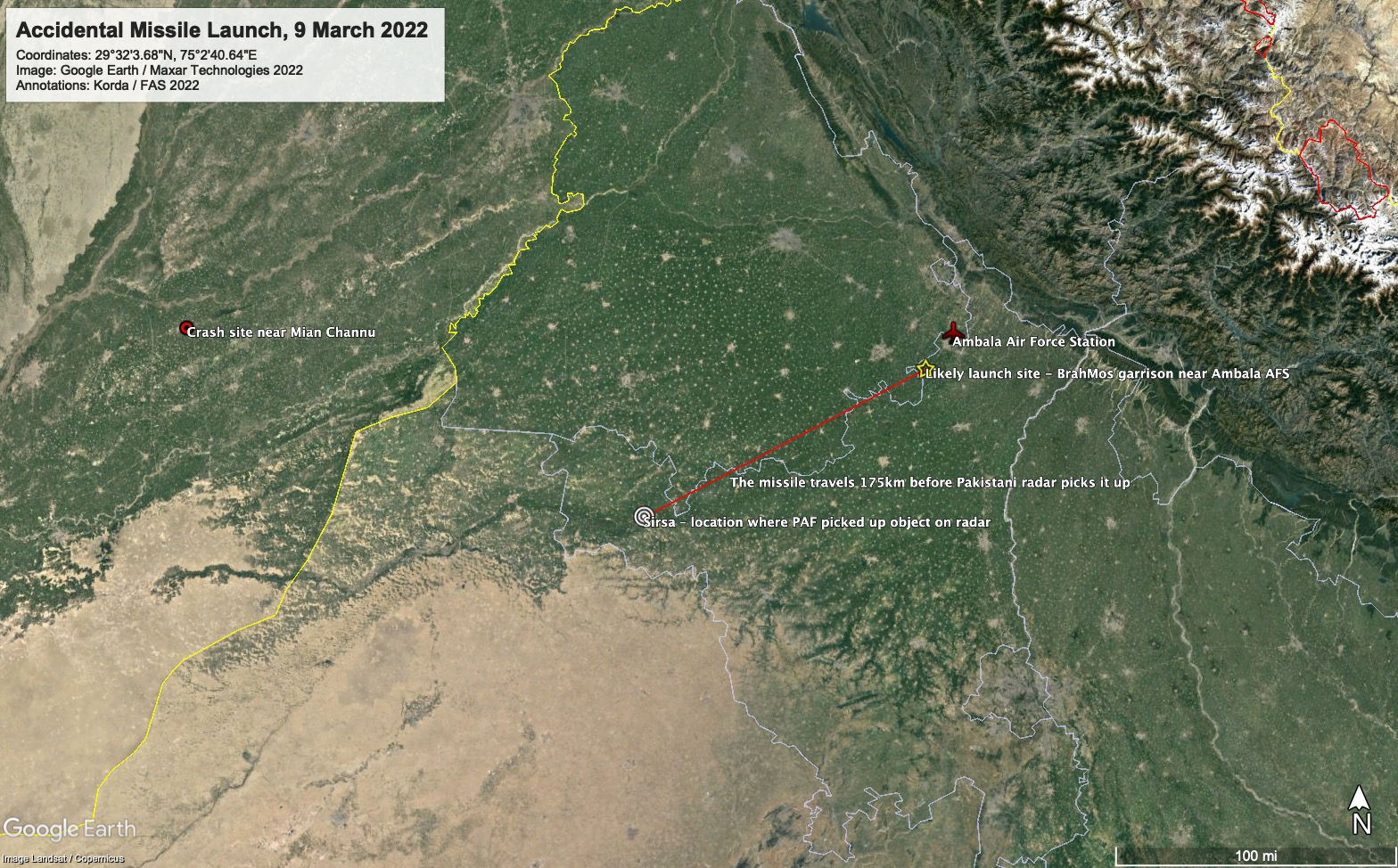
Annotated Google Earth image showing the 175 kilometer distance between the likely launch site and Pakistan’s radar pickup.
Furthermore, Pakistani officials announced on March 10th that the missile’s original destination was likely to be the Mahajan Field Firing Range in Rajasthan, before it suddenly turned and headed northwest into Pakistan. However, Indian defence sources have since suggested that the missile was not actually headed for the Mahajan Field Firing Range, but instead was “follow[ing] the trajectory that it would have in case of a conflict, but ‘certain factors’ played a role in ensuring that any pre-fed target was out of danger.” Given that the impact site was not near any critical military or political infrastructure, this could suggest that the cruise missile had its wartime mid-flight trajectory waypoints pre-loaded into the system, but its actual target had not yet been selected. If this is the case, then this targeting practice would be similar in nature to how some other nuclear-armed states target their missiles at the open ocean during peacetime––precisely in case of incidents like this one. Although the missile still landed on Pakistani territory, the fact that it did not hit any critical targets prevented the crisis from escalating. It is worth noting, however, that this would certainly not be the case if the missile had actually injured or killed anyone.
During the March 10th press conference, Pakistani officials noted that the Pakistan Air Force did not attempt to shoot down the missile because “the measures in place in times of war or in times of escalation are different [from those] in peace time.” However, India’s challenges to Pakistan’s narrative also raise significant questions about whether the Pakistan Air Force was able to accurately track the missile correctly. If not, then this raises the possibility of miscalculation or miscommunication, and crisis stability would be seriously eroded if a similar situation occurred during a time of heightened tensions.
Were any civilian aircraft put in danger?
In its public statements, Pakistan has emphasized that the accidental missile launch could have put civilian flights in danger, as India did not issue a Notice to Airmen (NOTAM) prior to launch. Governments typically issue NOTAMs in conjunction with missile tests, in order to inform civilian aircraft to avoid a particular patch of airspace during the launch window. Given that India did not issue one, a time-lapse video prepared by Flightradar24 showed that there were several civilian flights passing very close to the missile’s flight path at the time of launch. The video erroneously suggests that the missile traveled in a straight line from Ambala to Mian Channu, when it appears to have dog-legged in mid-flight; however, the video is still a useful resource to demonstrate how crowded the skies were at the time of the accident.
A screenshot of a video prepared by Flightradar24, showing that there were several civilian flights passing very close to the missile’s flight path at the time of launch.
Why was India’s response so poor?
Given the seriousness of the incident, India’s delayed response has been particularly striking. Immediately following the accidental launch, India could have alerted Pakistan using its high-level military hotlines; however, Pakistani officials stated that it did not do so. Additionally, India waited two days after the incident before issuing a short public statement.
India’s poor response to this unprecedented incident has serious implications for crisis stability between the two countries. According to DNA India, in the absence of clarification from India, Pakistan Air Force’s Air Defence Operations Centre immediately suspended all military and civilian aircraft for nearly six hours, and reportedly placed frontline bases and strike aircraft on high alert. Defence sources stated that these bases remained on alert until 13:00 PKT on March 14th. Pakistani officials appeared to confirm this, noting that “whatever procedures were to start, whatever tactical actions had to be taken, they were taken.”
We were very, very lucky
Thankfully, this incident took place during a period of relative peacetime between the two nuclear-armed countries. However, in recent years India and Pakistan have openly engaged in conventional warfare in the context of border skirmishes. In one instance, Pakistani military officials even activated the National Command Authority––the mechanism that directs the country’s nuclear arsenal––as a signal to India. At the time, the spokesperson of the Pakistan Armed Forces not-so-subtly told the media, “I hope you know what the NCA means and what it constitutes.”
If this same accidental launch had taken place during the 2019 Balakot crisis, or a similar incident, India’s actions were woefully deficient and could have propelled the crisis into a very dangerous phase.
Furthermore, as we have written previously, in recent years India’s rocket forces have increasingly worked to “canisterize” their missiles by storing them inside sealed, climate-controlled tubes. In this configuration, the warhead can be permanently mated with the missile instead of having to be installed prior to launch, which would significantly reduce the amount of time needed to launch nuclear weapons in a crisis.
This is a new feature of India’s Strategic Forces Command’s increased emphasis on readiness. In recent years, former senior civilian and military officials have reportedly suggested in interviews that “some portion of India’s nuclear force, particularly those weapons and capabilities designed for use against Pakistan, are now kept at a high state of readiness, capable of being operationalized and released within seconds or minutes in a crisis—not hours, as had been assumed.”
This would likely cause Pakistan to increase the readiness of its missiles as well and shorten its launch procedures––steps that could increase crisis instability and potentially raise the likelihood of nuclear use in a regional crisis. As Vipin Narang and Christopher Clary noted in a 2019 article for International Security, this development “enables India to possibly release a full counterforce strike with few indications to Pakistan that it was coming (a necessary precondition for success). If Pakistan believed that India had a ‘comprehensive first strike’ strategy and with no indication of when a strike was coming, crisis instability would be amplified significantly.”
India’s recent missile accident––and the deficient political and military responses from both parties––suggests that regional crisis instability is less stable than previously assumed. To that end, this crisis should provide an opportunity for both India and Pakistan to collaboratively review their communications procedures, in order to ensure that any future accidents prompt diplomatic responses, rather than military ones.
Background Information:
- “Indian Nuclear Forces, 2020,” FAS Nuclear Notebook, Bulletin of the Atomic Scientists, July/August 2020.
- “Pakistan Nuclear Weapons, 2021,” FAS Nuclear Notebook, Bulletin of the Atomic Scientists, Sept/Oct 2021.
- “India’s Nuclear Arsenal Takes A Big Step Forward,” FAS Strategic Security Blog, Dec 2021.
- Status of World Nuclear Forces, Federation of American Scientists
This article was made possible with generous support from the John D. and Catherine T. MacArthur Foundation, the New-Land Foundation, the Prospect Hill Foundation, and the Ploughshares Fund. The statements made and views expressed are solely the responsibility of the author.
*[Note: This type of missile accident has apparently happened before; on 11 September 1986, a Soviet missile flew more than 1,500 off-course and landed in China. Thank you to the excellent Stephen Schwartz for the historical reference.]
Categories: Arms Control, ballistic missiles, Deterrence, Disarmament, India, Nuclear Weapons, Pakistan
After Trump Secrecy, Biden Administration Restores US Nuclear Weapons Transparency
[Updated] The Biden administration yesterday afternoon declassified the number of nuclear weapons the United States possesses. The act reverses the secrecy of the Trump administration, which denied release of the number for three years, and restores the nuclear transparency of the Obama administration.
FAS’ Steve Aftergood asked for this information in March 2021. We have still not received an official response.
Although a victory for nuclear transparency, the data shows only very limited nuclear weapons reductions in recent years – a stark reminder of the international nuclear climate, domestic policies, and that a lot more work is needed to reduce nuclear dangers.
Stockpile Numbers
According to the new data, the United States possessed a total of 3,750 nuclear warheads in the Department of Defense nuclear weapons stockpile as of September 2020. That number is only 50 warheads less than our estimate of 3,800 warheads from early this year.
The 3,750-warhead number is only 72 warheads fewer than in September 2017, the last number made available before the Trump administration closed the books.
That reduction is by any measure mediocre. In its announcement about the new stockpile numbers, the US Department of State highlights that the current stockpile of 3,750 warheads “represents an approximate 88 percent reduction in the stockpile from its maximum (31,255) at the end of fiscal year 1967, and an approximate 83 percent reduction from its level (22,217) when the Berlin Wall fell in late 1989.” While that is true and an amazing accomplishment, the fact remains that the vast majority of that reduction happened in two phases during the H.W. Bush and W. Bush administrations. Since 2008 the reduction has been slow and limited. The trend is that the reduction is decreasing and leveling out.
A peculiar revelation in the new data is that it shows that the stockpile increased by 20 warheads between September 2018 and September 2019 when Trump was in office. The increase is not explained but one possibility is that it reflects the production of the new W76-2 low-yield warhead that the Trump administration rushed into production in response to what it said was Russia’s plans for first-use of tactical nuclear weapons. The first W76-2 was produced in February 2019, NNSA was scheduled to deliver all the warheads by end of Fiscal Year 2019, but the W76-2 wasn’t completed until June 2020. Arkin and Kristensen reported in January 2020 that the first W76-2s had been deployed, which was later confirmed by the Pentagon.
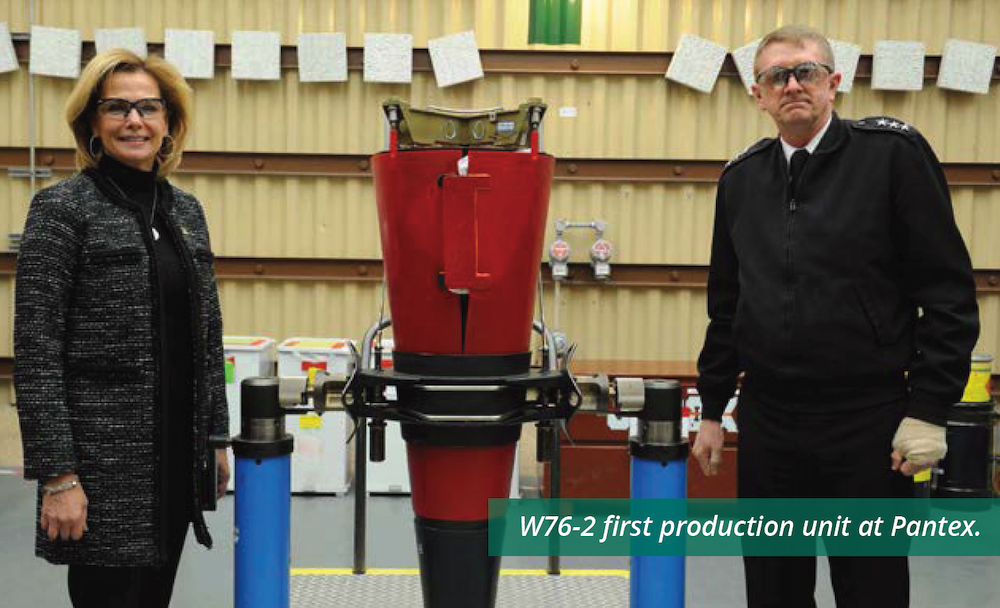
It is possible (but unconfirmed) that the 20-warhead stockpile increase between 2018 and 2019 was caused by production of the Trump administration’s W76-2 low-yield Trident warhead. Image: NNSA.
The Trump administration’s brief increase of the stockpile is only the second time the United States has increased its number of nuclear warheads since the Cold War. The first time was in 1995-1996 when the Clinton administration increased the stockpile by 107 warheads. Since the W76-2 production continued after September 2019, the increase of 20 warheads should not be misinterpreted as being the final number of W76-2 warheads. After the 2018-2019 increase, the stockpile number dropped again by 55 warheads.
Update: Another possibility for the brief stockpile increase is that a small number of retired warheads were returned to the stockpile. This could potentially be B83-1 bombs that the Trump administration decided to retain instead of retiring with the fielding of the B61-12. It could potentially also be retired warheads brought in as feedstock for new weapon systems such as the planned nuclear sea-launched cruise missile. We just don’t know at this point.
Apparently, the nuclear modernization program supported by both Republicans and most Democrats, will result in significant additional reductions of the stockpile. In 2016, the former head of the Navy’s Strategic Systems Program, Vice Admiral Terry Benedict, said that once the W76-1 warhead production was completed by the end of FY2019, the W76-0 warheads that had not been converted to W76-1 would be retired and the total number of W76 warheads in the stockpile decrease by nearly 50%.
At the same time, the Pentagon’s Principal Deputy Assistant Secretary of Defense for Nuclear, Chemical, and Biological Defense Programs, Arthur T. Hopkins, told Congress that production and fielding of the B61-12 bomb would “result in a nearly 50 percent reduction in the number of nuclear gravity bombs in the stockpile” and “facilitate the removal from the stockpile of the last megaton-class weapon––the B83-1.”
Production of the W76-1 has now been completed but the promised reduction is not yet visible in the stockpile data – unless the excess warheads were gradually removed during the production years. The B61-12 has not been fielded yet so the gravity bomb reduction presumably will not happen until the mid-2020s.
Whatever the number of the additional stockpile reduction is, it is not planned to be nice to Kremlin and Beijing but because the US military doesn’t need the excess warheads anymore. Whether Russia and China’s nuclear increases will cause the Biden administration to change the plan outlined by Benedict and Hopkins will be decided by the Nuclear Posture Review.
Dismantlement Numbers
The data also shows that the United States as of September 2020 had about 2,000 retired warheads in storage awaiting dismantlement. Retired warheads are owned by the Department of Energy and not part of the DOD stockpile.
That number matches the available data. Former Secretary of State John Kerry said in 2015 that there were about 2,500 retired weapons left (as of September 2014). Since then, 1,432 warheads have been dismantled and an additional 967 weapons retired, which would leave just over 2,000 warheads in the dismantlement queue.
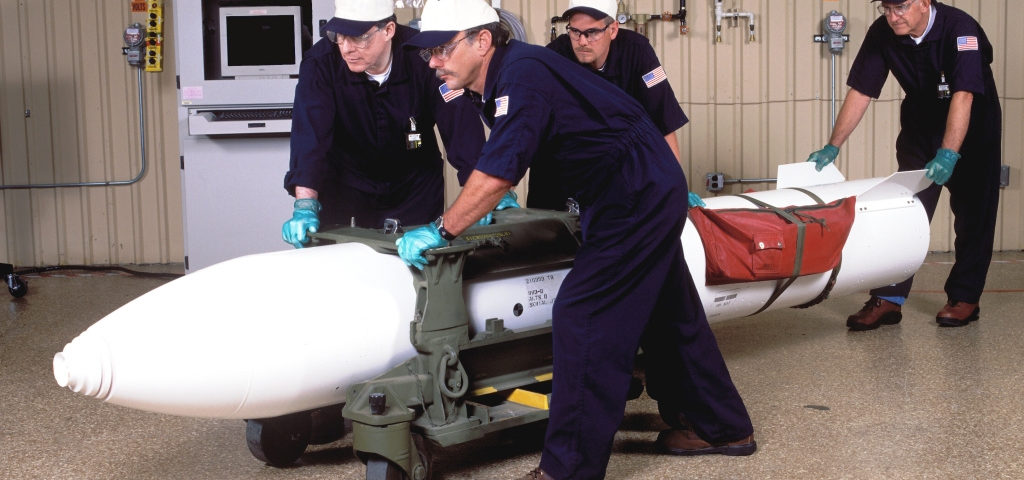
Approximately 2,000 retired warheads away dismantlement, including the B83 megaton gravity bomb. More are expected to follow during the next decade. Image: NNSA.
In our estimate from early this year, we thought the dismantlement queue had dropped to 1,750 warheads because we assumed the annual dismantlement rate had remained around 300. But as the data shows, both the Trump and Biden administrations reduced the number of warheads being dismantled per year.
In 2016, NNSA stated that it “will increase weapons dismantlement by 20 percent starting in FY 2018” and that the “accelerated rate will allow NNSA to complete the dismantlement commitment a year early, before the end of FY 2021.” NNSA reaffirmed in 2018, that all warheads retired prior to 2009 would be dismantled by end-FY 2022.
This pledge appears to have faded from recent documents after the 2018 Nuclear Posture Review was published. Instead, the annual number of warheads dismantled has decreased since FY 2018. Is it still the goal? Some of the warheads that should have been dismantled but are still with us reportedly include the W84 warheads from the ground-launched cruise missiles that were eliminated by the 1987 INF treaty and retired well before 2009.
Many of the warheads in the current dismantlement queue were retired after 2009. At the current rate of 184 warheads dismantled per year, it will take more than a decade to dismantle the current backlog. Once the excess W76s and old gravity bombs enter the queue, it will take even longer.
In Context
We commend the Biden administration for reversing the Trump administration’s shortsighted and counterproductive nuclear secrecy and restore transparency to the US nuclear weapons stockpile. This decision is a heavy lifting at a time when so-called Great Power Competition is overtaking defense and arms control analysis. The Federation of American Scientists has for years advocated for increased transparency of nuclear arsenals and have worked to provide that through our estimates of nuclear weapons arsenals.
Although the recent reductions shown in stockpile and dismantlement data are modest, to put it mildly, we believe declassification is the right decision because making the record public will help US diplomats make the case that the United States is continuing its efforts to reduce nuclear arsenals and increase nuclear transparency. This is especially important in the context of the upcoming January 2022 Review Conference for the Treaty on the Non-Proliferation of Nuclear Weapons. Dissatisfaction with the lackluster disarmament progress – and a belief that the nuclear-armed states are walking back decades of arms control progress with their excessive nuclear modernization programs and dangerous changes to operations and strategy – have fueled support for the Treaty on the Prohibition of Nuclear Weapons (TPNW).
The decision to disclose the stockpile and dismantlement data will also enhance the US credibility when urging other nuclear-armed states to be more transparent about their arsenals. We have no illusions that Russia or China will follow the example in the short term, but keeping the US numbers secret will certainly not help. And over time, the disclosure can help shape discussions and norms about nuclear transparency to shape future decisions. This is also important because the Trump secrecy recently provided cover for the United Kingdom to reduce information about its nuclear forces.
Hardliners will no doubt criticize the Biden administration’s decision to disclose the stockpile and dismantlement data. They will argue that past nuclear transparency has not given the United States any leverage, that nuclear-armed states previously have not followed the example, and it that makes the United States look naive – even irresponsible – in view of Russia and China’s nuclear secrecy and build-up.
On the contrary: without transparency the United States has no case. Past transparency has given the United States leverage to defend its record and promote its policies in international fora, dismiss rumors and exaggerations about its nuclear arsenal, and publicly and privately challenge other nuclear-armed states’ secrecy and promote nuclear transparency. And since the disclosure does not reveal any critical national security information, there is no reason to classify the stockpile and dismantlement data.
Hardliners obviously will have to acknowledge that the data shows that there has been no unilateral US disarmament but only a very modest reduction in recent years. And although there appear to be additional unilateral reductions built into the modernization programs, those are actually programs that have been supported and defended by the hardliners.
Now it is up to the Biden administration’s Nuclear Posture Review to articulate how and to what extent those plans support and strengthen US national security and nonproliferation objectives. Arms control obviously will have to be part of that assessment. The declassified stockpile and dismantlement data will help make the case that additional reductions are both needed and possible.
Background Information:
- US Department of State, Transparency in the U.S. Nuclear Weapons Stockpile, Fact Sheet, October 5, 2021
- “United States Nuclear Forces, 2021,” FAS Nuclear Notebook, Bulletin of the Atomic Scientists, March/April 2021
- “Pentagon Slams Door On Nuclear Weapons Stockpile Transparency,” FAS Strategic Security Blog, April 17, 2019
- Status of World Nuclear Forces, Federation of American Scientists global arsenal page
This article was made possible by generous support from the John D. and Catherine T. MacArthur Foundation, the New Land Foundation, the Prospect Hill Foundation, and the Ploughshares Fund. The statements made and views expressed are solely the responsibility of the authors.
Reevaluating U.S. Military Use of Drone Technology
In the 21st century, drone technology has become commonplace in warfare. In fact, drones are increasingly preferred by both state and non-state actors over other modes of warfare. But widespread use of drones in war engenders considerable controversy. Civilian casualties and collateral damage have grown alongside drone deployment with little accountability or transparency. As the Biden-Harris Administration works to rebuild America’s place on the world stage and as a member of the global community, the Administration should boost accountability for civilian deaths by rethinking when and how drones are used. Specifically, the Administration should (1) sign an executive order to boost transparency and oversight of drone technology used by the military, (2) work with Congress to review use of drones in U.S. military operations, and (3) lead efforts to launch an international drone accountability regime.
Challenge and Opportunity
In the last two decades, the use of drone strikes by the U.S. military against terrorist and militant organizations has expanded. Drones have been utilized so frequently by the U.S. government because they offer numerous advantages over manned aircraft. Drones are a cost-effective way to keep American boots off the ground and safe from danger. The fact that drones lack a human pilot means that fatigue is also lessened in military operations. Drone operators can hand off controls without any downtime, and drones can offer the same accuracy and lethality as manned aircraft. Drones can also serve as a valuable tool in surveillance operations.
But there is also a downside to this technology that makes warfare easy. Commanders are more likely to greenlight attacks when those attacks pose less of a direct risk to American military personnel. As the use of drones has proliferated, so too have the number of drone strikes ordered by the U.S. military — and the accompanying losses of civilian life.
Beginning in the early 2000s and into President Obama’s Administration, the use of drone technology increased. A 2005-2030 roadmap published by the Department of Defense noted that twenty types of unmanned aerial vehicles (UAVs) were flown for 100,000 hours in conflicts in Iraq and Afghanistan. Under President Obama, an estimated 3,797 people, including 324 civilians, were killed in the 542 strikes carried out during the eight years of his Administration. This was the result of a dramatic increase in drone warfare. In his second term, President Obama took steps to reign in the use of drone warfare but beginning in 2017, President Trump’s Administration took it to new heights. In his first two years in office, President Trump launched more drone strikes that President Obama did in eight years. Reporting suggests that with the use of drones, President Trump launched more attacks in Yemen than all previous U.S. presidents combined. These drone strikes together killed between 86 and 154 civilians.
President Obama signed Executive Order 13732 in 2016, which required the Central Intelligence Agency (CIA) to review and investigate drone strikes involving civilian casualties and offer payment to families of those killed. The executive order also required the Director of National Intelligence to release annual summaries of all U.S. drone strikes conducted, accompanied by assessments of how many civilians died as a result of those strikes. But President Trump revoked this policy in 2019, arguing that the provisions were superfluous and distracting. As the use of drones increased dramatically in the first year of President Trump’s Administration, the United States also disclosed fewer details about the frequencies and fatalities of these strikes.
The time is ripe for the Biden-Harris Administration to reevaluate and rein in the use of drone warfare to both boost U.S. accountability for civilian deaths and restore America’s leadership on the world stage.
Plan of Action
The Biden-Harris Administration should take three essential actions to improve transparency and oversight of U.S. drone operations. These actions are crucial to restoring America’s place and reputation in the international community.
First, President Biden should sign an executive order committing to boost transparency and oversight of drone technology used by the U.S. government. On the first day of his Administration, President Biden imposed temporary limits on drone strikes outside of battlefields in Afghanistan, Syria, and Iraq and ordered a review of U.S. drone policy with respect to counterterrorism operations. This was a welcome step, and the Administration can build on it to promote greater transparency without compromising U.S. national security. An Executive Order to Reevaluate U.S. Military Use of Drone Technology to Boost Accountability for Civilian Deaths can and should reinstate much of Executive Order 13732, but also go further. Specifically, the executive order should:
- Commit to reduce the use of drone strikes overall.
- Commit to limit collateral damage when drone technology is used.
- Require the CIA to release biannual summaries of U.S. drone strikes, accompanied by assessments of civilian casualties.
- Offer payment to the families of civilians killed as a result of a U.S. drone strikes.
- Require the CIA, the Department of Justice, and the Department of Defense to conduct a thorough joint investigation of all drone use resulting in civilian deaths.
- Provide quarterly briefings to Congress on the use of drone technology and provide reports to relevant Congressional committees on investigations into drone strikes that result in civilian casualties.
To complement this executive order, the Biden-Harris Administration’s review of U.S. drone policy should include an interagency process involving the CIA, the National Security Council (NSC), and the Departments of Defense, State, and Justice to evaluate the increased use of drones over the past decade, analyze trends in technology shaping the future use of drones, and devise a coordinated path forward to (1) increase accountability for use of drone warfare, and (2) boost American national security through a strategic counterterrorism strategy that minimizes the extraneous use of drones.
Second, President Biden should work with Congress to review the use of drones in U.S. military operations, including use of drones both within and beyond active military conflict. The Administration should provide members of key Congressional committees (e.g., the Senate Foreign Relations, Armed Services, and Intelligence Committees as well as the House Foreign Affairs, Armed Services, and Intelligence Committees) with both classified and public briefings on the Administration’s counterterrorism strategy and the role of drone technology in advancing military operations. Congress, in turn, should conduct public hearings on these topics and should ultimately act to repeal and replace the outdated 2001 and 2002 Authorizations for the Use of Military Force (AUMF) which have been used by multiple presidents to justify continued military action across the globe, including drone strikes.
In fact, the Biden-Harris Administration has pushed for these AUMFs to be replaced with a “narrow and specific framework that will ensure we can protect Americans from terrorist threats while ending forever wars,” according to a statement by Press Secretary Jen Psaki in March 2021. The 2001 AUMF was passed after the Sept 11. Terrorist attacks and the 2002 AUMF was passed in the fall of 2002 ahead of the U.S.- led invasion of Iraq in 2003.
Third, as one of the largest producers and sellers of drone technology worldwide, the United States should lead efforts to launch an international drone accountability regime. This effort, which could be launched through an existing international organization like the United Nations, would bring together states to:
- Sign a treaty that creates a commitment to abide by a set of international standards on the use of drone warfare, including a commitment to reduce collateral damage and loss of civilian life.
- Review and evaluate use of drone technology by nation, especially by global military leaders.
- Investigate and make public instances of drone-technology abuse.
The global accountability effort will require development of a strong set of international standards that regulate the use of drone technology — standards that will make the United States and the world safer. These international standards should include commitments by abiding states and non-state actors to: (1) commit to reducing the use of drone strikes and limiting collateral damage; (2) issue a public statement following drone strikes resulting in civilian casualties explaining the reason for the strike and relevant surrounding circumstances; and (3) publish summaries of all casualties and damage resulting from drone strikes. (4) Additionally, abiding parties that sell or purchase drone technology should commit to only sell or purchase drone technology from other abiding parties.
Conclusion
The growing ubiquity of drone strikes within U.S. military operations demands action to increase transparency and accountability. When drone strikes are used too freely, unnecessary civilian casualties can result — as recent history has already demonstrated. By strategically rethinking how the United States uses drones for warfare, the Biden-Harris Administration can rebuild accountability for civilian deaths, restore transparency to our nation’s use of drone technology, and repair our nation’s reputation on the world stage, all without compromising military operations or national security.
President Biden can take immediate action by issuing an executive order that builds on the drone-accountability policies put in place during the late Obama era while setting a new standard for the international community, as well as by ordering an interagency review of the role that drones play in U.S. operations. Further, President Biden should work with Congress to repeal and replace the outdated 2001 and 2002 AUMFs and to consider how drones can and should be used responsibly in warfare. These steps will be essential to restoring confidence in U.S. military operations both at home and abroad. Finally, as the U.S. seeks to rebuild its position in the global community, efforts led by the Biden-Harris Administration to establish an international drone-accountability regime can help check the growing use of drones in warfare globally: a result that will strengthen the security of the United States and the world.
The unmanned nature of drone warfare does indeed limit U.S. military casualties. But the widened use of drone warfare by the American military and resulting casualties poses risks to Americans. Civilian casualties and collateral damage that result from reckless drone strikes in many instances have provoked the targets of those strikes to retaliate against American troops.
First New START Data After Extension Shows Compliance
The first public release of New START aggregate numbers since the United States and Russia in February extended the agreement for five years shows the treaty continues to limit the two nuclear powers strategic offensive nuclear forces.
Continued adherence to the New START limits is one of the few positive signs in the otherwise frosty relations between the two countries.
The ten years of aggregate data published so far looks like this:
Combined Forces
The latest set of this data shows the situation as of March 1, 2021. As of that date, the two countries possessed a combined total of 1,567 accountable strategic missiles and heavy bombers, of which 1,168 launchers were deployed with 2,813 warheads. That is a slight decrease in the number of deployed launchers and warheads compared with six months ago (note: the combined warhead number is actually about 100 too high because each deployed bomber is counted as one weapon even though neither country’s bombers carry weapons under normal circumstances).
Compared with September 2020, the data shows the two countries combined increased the total number of strategic launchers by 3, decreased combined deployed strategic launchers by 17, and decreased the combined deployed strategic warheads by 91. Of these numbers, only the “3” is real; the other changes reflect natural fluctuations as launchers move in and out of maintenance or are being upgraded.
In terms of the total effect of the treaty, the data shows the two countries since February 2011 combined have cut 422 strategic launchers from their arsenals, reduced deployed strategic launchers by 235, and reduced the number of deployed strategic warheads by 524. However, it is important to remind that this warhead reduction is but a fraction (just over 6 percent) of the estimated 8,297 warheads that remain in the two countries combined nuclear weapons stockpiles (just over 4 percent if counting their total combined inventories of 11,807 stockpiled and retired (but yet to be dismantled) warheads).
The United States
The data shows the United States currently possessing 800 strategic launchers, exactly the maxim number allowed by the treaty, of which 651 are deployed with 1,357 warheads attributed to them. This is a decrease of 24 deployed strategic launchers and 100 deployed strategic warheads over the past 6 months. These are not actual decreases but reflect normal fluctuations caused by launchers moving in and out of maintenance. The United States has not reduced its total inventory of strategic launchers since 2017.
The aggregate data does not reveal how many warheads are attributed to the three legs of the triad. The full unclassified data set will be released later. But if one assumes the number of deployed bombers and deployed ICBMs are the same as in the September 2020 data, then the SSBNs carry 909 warheads on 200 deployed Trident II SLBMs. That is a decrease of 100 warheads on the SSBN force compared with September, or an average of 4-5 warheads per deployed missile. Overall, this accounts for 67 percent of all the 1,357 warheads attributed to the deployed strategic launchers (nearly 70 percent if excluding the “fake” 50 bomber weapons included in the official count).
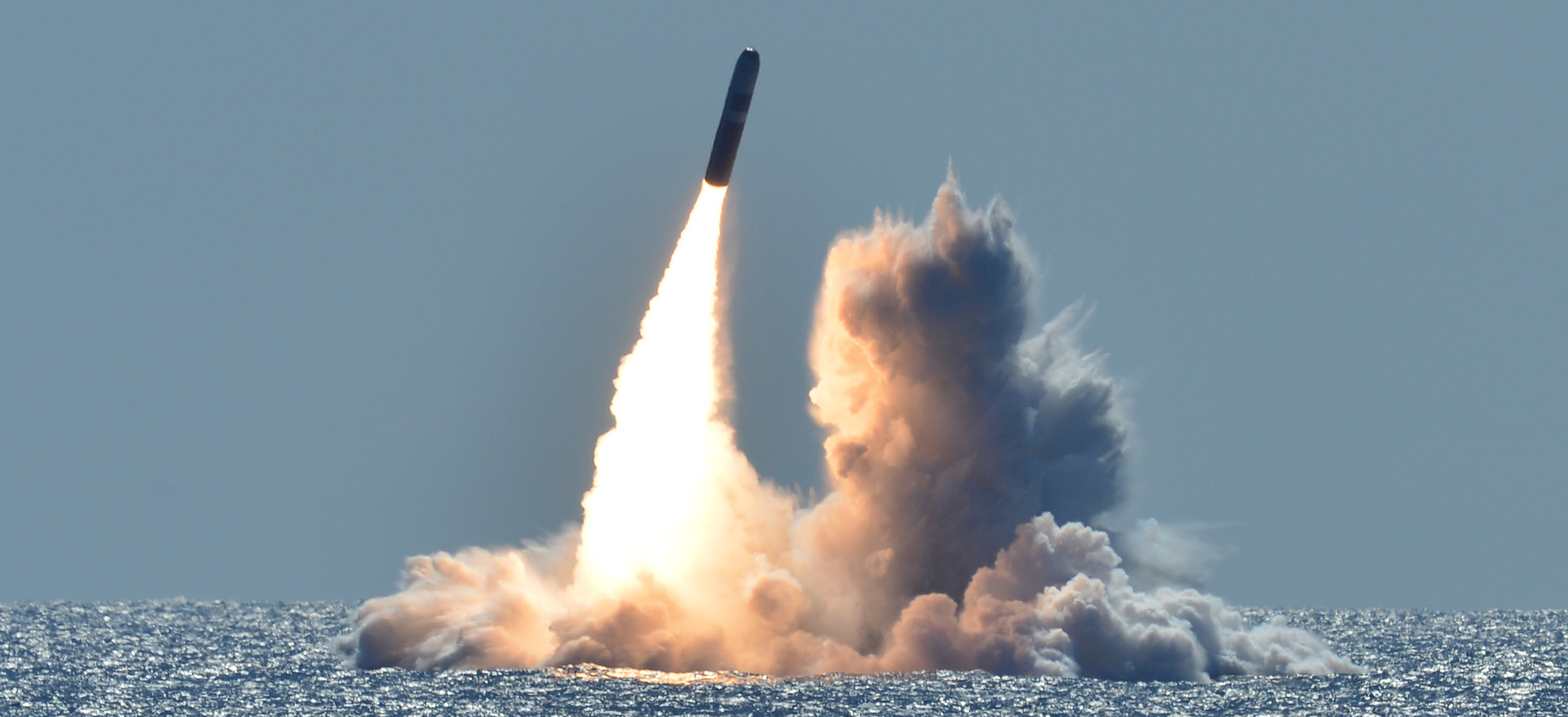
The New START data indicates that the United States as of March 1, 2021 deployed approximately 909 warheads on ballistic missile onboard its strategic submarines.
Compared with February 2011, the United States has reduced its inventory of strategic launchers by 324, deployed launchers by 231, and deployed strategic warheads by 443. While important, the warhead reduction represents only a small fraction (about 12 percent) of the 3,800 warheads that remain in the U.S. stockpile (less than 8 percent if counting total inventory of 5,800 stockpiled and retired (but yet to be dismantled) warheads).
The Russian Federation
The New START data shows Russia with an inventory of 767 strategic launchers, of which 517 are deployed with 1,456 warheads attributed to them. Compared with six months ago, this is an increase of 7 deployed launchers and 9 deployed strategic warheads. The change reflects fluctuations caused by launcher maintenance and upgrade work to new systems.
Compared with February 2011, Russia has cut its inventory of strategic launchers by 98, deployed launchers by 4, and deployed strategic warheads by 81. This modest warhead reduction represents less than 2 percent of the estimated 4,497 warheads that remain in Russia’s nuclear weapons stockpile (only 1.3 percent if counting the total inventory of 6,257 stockpiled and retired (but yet to be dismantled) Russian warheads).
Compared with 2011, the Russian reductions accomplished under New START are smaller than the U.S. reductions because Russia had fewer strategic forces than the United States when the treaty entered into force in 2011.
Build-up, What Build-up?
With frequent claims by U.S. officials that Russia is increasing its nuclear arsenal, which may be happening in some categories, it is interesting that despite a significant modernization program, the New START data shows this increase is not happening in the size of Russia’s accountable strategic nuclear forces. (The number of strategic-range nuclear forces outside New START is minuscule.)
On the contrary, the New START data shows that Russia has 134 deployed strategic launchers less than the United States, a significant gap roughly equal to the number of missiles in an entire US Air Force ICBM wing. It is significant that Russia despite its modernization programs so far has not sought to reduce this gap by deploying more strategic launchers. Instead, the Russian launcher deficit has been increasing by nearly one-third since its lowest point in February 2018.

Although Russia is modernizing its nuclear forces, such as those of this SS-27 Mod 2 (RS-24, Yars) ICBM exercise near Bernaul, this has not yet resulted in an increase of its strategic nuclear weapons.
Instead, the Russian military appears to try to compensate for the launcher disparity by increasing the number of warheads that can be carried on the newer missiles (SS-27 Mod 2, Yars, and SS-N-32, Bulava) that are replacing older types (SS-25, Topol, and SS-N-18, Vysota). Thanks to the New START treaty limit, many of these warheads are not deployed on the missiles under normal circumstance but are stored and could potentially be uploaded onto the launchers in a crisis. The United States also has such an upload capability for its larger inventory of launchers and therefore is not at a strategic disadvantage.
Two of Russia’s new strategic nuclear weapons (SS-19 Mod 4, Avangard, and SS-29, Sarmat) are covered by New START if formally incorporated. Other types (Poseidon nuclear-powered torpedo, and Burevestnik nuclear-powered ground-launched cruise missile) are not yet deployed and appear to be planned in relatively small numbers. They do not appear capable of upsetting the strategic balance in the foreseeable future. The treaty includes provisions for including new weapon types, if the two sides agree.
Inspections and Notifications
In addition to the New START data, the U.S. State Department has also updated the overview of part of its treaty verification activities. The data shows that the two sides since February 2011 have carried out 328 on-site inspections of each other’s strategic nuclear forces and exchanged 21,727 notifications of launcher movements and activities. Nearly 860 of those notifications were exchanged since September 2020.
Importantly, due to the Coronavirus outbreak, there have been no on-site inspections conducted since April 1, 2020. Instead, notification exchanges and National Technical Means of verification have provided adequate verification. Nonetheless, on-site inspection can hopefully be resumed soon.
This inspection and notification regime and record are crucial parts of the treaty and increasingly important for U.S.-Russian strategic relations as other treaties and agreements have been scuttled.
Looking Ahead
Although the New START treaty has been extended for five years and it appears to be working, that is no reason to be complacent. The United States and Russia should undertake detailed and ongoing negotiations about what a follow-on treaty will look like, so they are ready well before the five-year extension runs out. The incompetent and brinkmanship negotiation style of the Trump administration fully demonstrated the risks and perils of waiting to the last minute. The Biden administration can and should do better.
Additional information:
This publication was made possible by generous support from the John D. and Catherine T. MacArthur Foundation, the New Land Foundation, the Ploughshares Fund, and the Prospect Hill Foundation. The statements made and views expressed are solely the responsibility of the author.
British Defense Review Ends Nuclear Reductions Era
[Article updated May 11, 2021] The United Kingdom announced yesterday that it has decided to abandon a previous plan to reduce it nuclear weapons stockpile to 180 by the mid-2020s and instead “move to an overall nuclear weapon stockpile of no more than 260 warheads.”
The decision makes Britain the first Western nuclear-armed state to increase its nuclear weapons stockpile since the end of the end of the Cold War. In terms of numbers, it takes Britain back to a stockpile size it had in the early-2000s. The change is part of “a shift to a more robust position on security and deterrence.”
The Review also decided that Britain will “no longer give public figures for our operational stockpile, deployed warhead or deployed missile numbers.” This counterproductive decision follows the earlier decision of the Trump administration to keep the nuclear stockpile number secret. By embracing nuclear secrecy, Britain effectively abdicates its ability to criticize Chinese or Russian secrecy about their nuclear arsenals.
The decision to increase the size of the future stockpile – and potentially deploy more warheads on British submarines – is but the latest example of nuclear-armed states invigorating a nuclear arms race and reversing progress toward reducing the world’s nuclear arsenals.
The British Nuclear Weapons Stockpile
The British government has never declassified the history of its nuclear weapons stockpile. Instead, it has occasionally published documents or made statements that gave overall numbers or percentages. The government announced in 2010 that it would have “no more than 225” warheads and later that the limit would be reduced to 180 by the mid-2020s. It is unknown how far the reduction of those approximately 45 warheads has progressed. If spread out evenly over the 15 years, the number might have reached just below 200 by now. But it is highly uncertain so illustrating the British stockpile comes with considerable uncertainty (In this article we conclude that the stockpile did not drop below the 225 ceiling set in 2010 and remains at that level today). The following graph is illustrative and based on previous statements and documents.

Note: This graph has been updated. The history of the United Kingdom nuclear weapons stockpile is still classified, so the graph is provided for illustrative purposes. Click on graph to view full size.
The timeline for the new stockpile limit of 260 warheads is not entirely clear but appears to be during the 2020s. The Review reflects an assessment out to 2030 but “establishes the Government’s overarching national security and international policy objectives, with priority actions, to 2025.”
The wording of the new warhead level is vague. The Review sets the number at “no more than 260 warheads.” The British government has subsequently explained the “260 figure is a ceiling, not a target.” Political damage control is probably part of that statement, but the number could potentially be somewhat lower – or it could be about 260.
Not all of the stockpiled warheads are deployed. The majority is called “operationally available,” which means they’re onboard three of the four SSBNs or can be loaded fairly quickly. The rest are a reserve as spares or undergoing maintenance. Since 2015, the number of “operationally available warheads” has been approximately 120, of which the number deployed on the single SSBN at sea has been reduced to 40.
Unlikely previous defense reviews, the Integrated Review does not include any information about how many of the stockpiled warheads will be operationally available, loaded onboard deployed submarines, or how many submarines will be at sea at any given time. This is a step back for British nuclear transparency. Based on statements from previous governments, however, the number of operationally available warheads under the Johnson posture might end up being similar to what it was during the Blair government: perhaps close to 160 warheads.
The stockpiled warheads that are not “operationally available” are likely stored at Coulport Ammunition Depot nearly the Faslane Submarine Base in Scotland (see image below). Warheads undergoing maintenance or upgrade to the Mk4A aeroshell are probably stored at AWE Burghfield or AWE Aldermaston west of London. Retired warheads are shipped to Burghfield for dismantlement and disposition.
In 2013, the UK government described the process: warheads “yet to be disassembled” are stored at Coulport or as “work in progress” at Burghfield. “A number of warheads identified in the [stockpile reduction] programme for reduction have been modified to render them unusable whilst others identified as no longer being required for service are currently stored and have not yet been disabled or modified.”
Those retired warheads that have not been “rendered unusable” are most likely the source for increasing the stockpile now. Britain doesn’t have the capacity to quickly produce 50-60 new warheads so it simply brings warheads out of retirement. Reconstituting those warheads can probably be done in a few years.
Nuclear Strategy and Targeting
The extent to which the increased stockpile will affect targeting requirement for Britain’s ballistic missile submarines remains to be seen. But the Review states that the stockpile increase comes in response to “the evolving security environment, including the developing range of technological and doctrinal threats.”
Russia is singled out as “the most acute direct threat to the UK” but the Review also contains what appears to be a subtle but clear nuclear threat against Iran (even though it doesn’t have nuclear weapons). After assuring the “UK will not use, or threaten to use, nuclear weapons against any non-nuclear weapon state party to the Treaty on the Non-Proliferation of Nuclear Weapons 1968 (NPT),” the Review adds: “This assurance does not apply to any state in material breach of those non-proliferation obligations.”
The difference between the stockpile limit number and operationally deployed warheads in previous government statements indicates that an increased stockpile limit of 260 warheads most likely will also result in an increase in the number of operationally available warheads and possibly the number of warheads onboard the submarines. An increased number of deployed warheads means an increased number of aimpoints. The United States shares strategic war plan details with the United Kingdom in support of NATO.
In 1998, there were fewer than 200 operationally available warheads. In 2007, that category was reduced to 160 warheads, of which 48 were onboard the submarine at sea. In 2015, that category was reduced to 120 warheads, of which 40 were onboard the single submarine on patrol. The Review states that “at least one [submarine] will always be on a Continuous At Sea Deterrent patrol” (CASD) “at several days’ notice to fire…to guarantee that the UK’s nuclear deterrent remains credible and effective against the full range of state nuclear threats from any direction.”
Perhaps the increased stockpile is intended to facilitate increased targeting of Russia. Perhaps it broadens targeting to other potential adversaries (China, Iran). Perhaps it increases targeting of non-nuclear strategic threats. Perhaps it’s a combination.
The US Connection
The British announcement to increase its stockpile is particularly sensitive now because it preempts the new Biden administration’s upcoming nuclear posture review. Given the nuclear developments in Russia and China, it already seemed unlikely that Biden would reduce the US stockpile further than previously planned. But nuclear proponents in the United States must be rejoicing; the British announcement makes it politically awkward for the Biden administration to reduce.
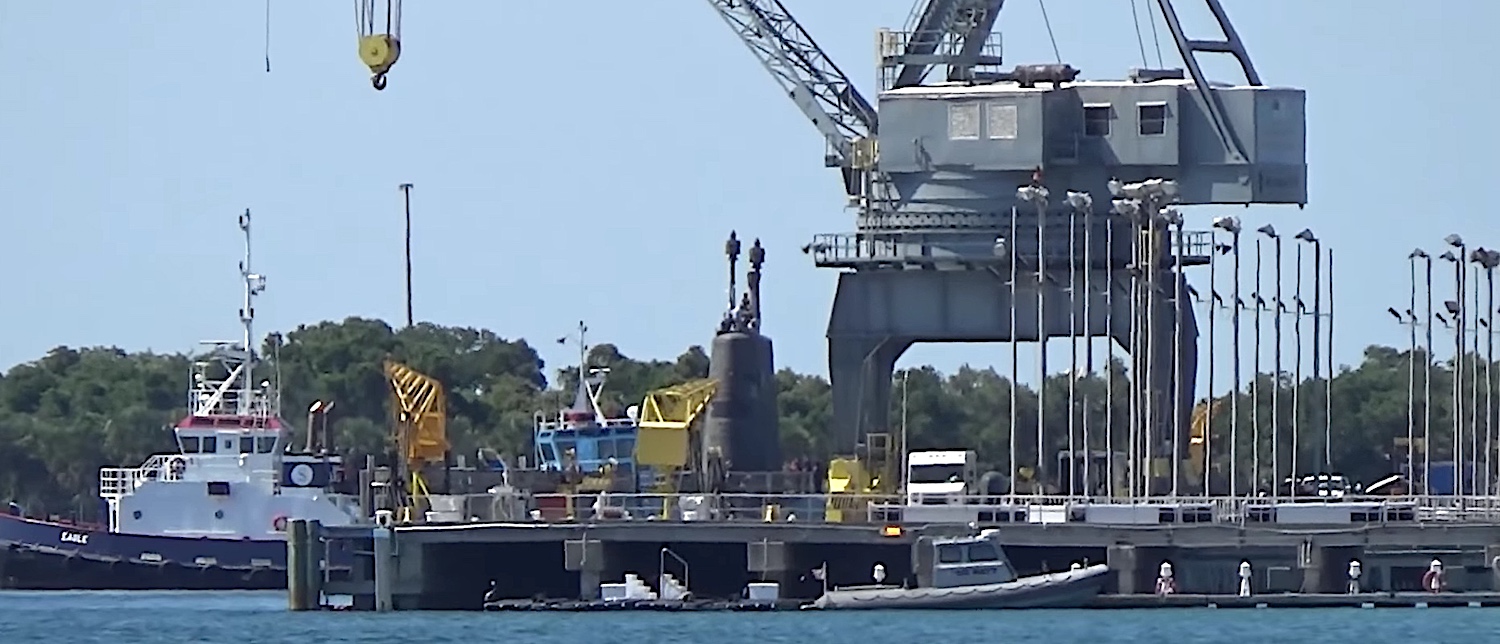
Britain does not own its own ballistic missiles but leases U.S. Trident II D5 missiles. British SSBNs conduct test flights off Florida after being serviced at Port Canaveral.
The current British warhead, known as the Holbrook, is thought to closely resemble the U.S. W76-0. The British warhead is so similar that it is part of the U.S. Department of Energy’s “W76 Needs” maintenance schedule. The Holbrook warhead is currently being backfitted with the new Mk4A aeroshell with enhanced targeting capability. Increasing the stockpile presumably will require buying additional Mk4A aeroshells from the United States.
But the Holbrook is getting old, so British officials have been busy lobbying the U.S. government about moving forward with its proposed new W93/Mk7 warhead, which will also form part of Britain’s next warhead design. Although a U.S. defense official has described the two programs as “two independent, development systems,” a British defense official subsequently explained that although they are “not exactly the same warhead…there is a very close connection in design terms and production terms.” Like the Holbrook, which is contained in the U.S. produced Mk4A reentry body, the new British warhead will be contained in the U.S. produced Mk7 reentry body.
It sounds like we can look forward to another 30 years of discussion about how independent the British deterrent is.
The NPT Context
The decision to increase the nuclear weapons stockpile strongly conflicts with the role Britain has played in nuclear disarmament efforts and the nuclear Nonproliferation Treaty (NPT) regime over the past three decades. All those efforts have been about reducing arsenals. The Review breaks with that legacy.
Nonetheless, the Review reiterates long-held British support for the NPT: “We remain committed to the long-term goal of a world without nuclear weapons. We continue to work for the preservation and strengthening of effective arms control, disarmament and non-proliferation measures, taking into account the prevailing security environment. We are strongly committed to full implementation of the NPT in all its aspects, including nuclear disarmament…” In fact, the commitment to NPT as an instrument for disarmament is so singular that the Review states that “there is no credible alternative route to nuclear disarmament.”
Although NPT’s Article VI does not explicitly prohibit Britain from increasing its nuclear stockpile, it obligates Britain to “pursue negotiations in good faith on effective measures relating to cessation of the nuclear arms race at an early date and to nuclear disarmament, and on a treaty on general and complete disarmament under strict and effective international control.”
Increasing the stockpile in response to Russia and other threats certainly seems to conflict with the goal of ending the nuclear arms race. Instead, it seems to embrace a race.
Moreover, British governments have explicitly linked stockpile reductions to its “obligations under Article six.” In 2015, for example, the U.K. delegation to the NPT Review Conference stated that the “United Kingdom remains firmly committed to step-by-step disarmament, and our obligations under Article Six. We announced in January that we have reduced the number of warheads on each of our deployed ballistic missile submarines from 48 to 40, and the number of operational missiles on each of those submarines to no more than eight.”
The decision to increase the stockpile clearly contradicts those assurances and obligations. That, and the decision to reduce nuclear transparency, will make it less credible for British diplomats to criticize Russia and China for increasing their stockpiles and hiding behind nuclear secrecy. It might also weaken Britain’s ability to appeal to Iran not to develop nuclear weapons.
In conclusion: Johnson has pulled a Trumpie that will boost Britains nuclear profile but do little to reduce nuclear dangers.
Additional information: United Kingdom Nuclear Weapons, 2021
This publication was made possible by generous support from the John D. and Catherine T. MacArthur Foundation, the New Land Foundation, the Ploughshares Fund, and the Prospect Hill Foundation. The statements made and views expressed are solely the responsibility of the author.
The Treaty on the Prohibition of Nuclear Weapons Enters Into Force Today
The Treaty on the Prohibition of Nuclear Weapons (TPNW) enters into force today, 90 days after the deposit of the 50th instrument of ratification. So far, a total of 86 countries have signed the treaty, which complements existing disarmament measures like the Non-Proliferation Treaty (NPT).
The TPNW is a significant milestone in the long and global effort to achieve a world free from nuclear weapons. The 86 countries that have signed so far are also signatories to the NPT––which also calls for nuclear disarmament––but signed on to the TPNW in apparent frustration over what they consider inadequate progress by the nuclear-armed states in fulfilling their NPT obligations. As we wrote in July 2020, on the 75th anniversary of the Trinity Nuclear Test:
Nuclear-armed states largely do not appear to consider nuclear disarmament to be an urgent global security, humanitarian, or environmental imperative. Instead, most states seem to consider disarmament as a type of chore mandated by the Non-Proliferation Treaty – and not one that they are seriously interested in completing in the foreseeable future.
It is increasingly rare to hear any officials from nuclear weapon states express a coherent rationale for pursuing disarmament other than as a result of the obligation to do so under the Non-Proliferation Treaty. Moreover, they seem increasingly focused on shifting the disarmament responsibility onto the non-nuclear states by arguing they first must create the security conditions that will make nuclear disarmament possible.
The Treaty on the Prohibition of Nuclear Weapons seeks to turn this reality on its head. Rather than listening to another half-century of excuses from the nuclear-armed states that they can’t disarm, the countries behind the TPNW seek to take the initiative and increase pressure on the nuclear-armed states to adopt disarmament measures.
Unfortunately, no matter how many countries sign it, the TPNW does not eliminate any nuclear weapons unless the nuclear-armed states join and implement the treaty’s provisions. They are not legally bound by the prohibition unless they sign the treaty. So far, they have refused, boycotted meetings, and even pressured countries not to sign on. Rather than a ban, they argue that “an incremental, step-by-step approach is the only practical option for making progress towards nuclear disarmament…”
However, decades of trying that approach has left the world with more than 13,000 nuclear weapons, led to a slowed pace of reductions, increasing modernization programs––and in some cases, increasing nuclear arsenals, worsening military tensions, reaffirmations of the enduring role and importance of nuclear weapons, and the discarding of arms control agreements. Non-nuclear armed states would seem justified in wanting to try something new.

FAS is honored that the United Nations Office for Disarmament Affairs uses our nuclear weapons estimates. For latest updates, go here.
Whether or not one believes the TPNW is the right approach, the Treaty is a reality and now in force. More NPT countries are likely to join. While the Treaty may not immediately create disarmament, it is supported by a significant number of the states party to the NPT. Additionally, the TPNW includes welcome and unprecedented provisions on humanitarian assistance and environmental remediation, which offer a bridge to nuclear-armed states and their allies by allowing them to engage with these provisions without immediately signing the treaty.
Now that the Treaty is in force, instead of continuing to boycott and reject their efforts and motivations of its supporters, the nuclear-armed states must work with them to achieve responsible reductions of nuclear forces and create the conditions that would allow them to be eliminated.
Background Information:
• UN: Treaty on the Prohibition of Nuclear Weapons (TPNW)
• FAS: Status of World Nuclear Forces
The Federation of American Scientists is honored to provide the world with the best non-classified estimates of the nuclear weapons arsenals. We are grateful for the financial support from the New Land Foundation, MacArthur Foundation, Ploughshares Fund, and the Prospect Hill Foundation to do this work. To explore this vast data, developed over many decades, start here.
Trump Administration Again Refuses To Disclose Nuclear Weapons Stockpile Size
The Trump administration has denied a request from the Federation of American Scientists to disclose the size of the US nuclear weapons stockpile and the number of dismantled warheads.
The denial was made by the Department of Defense Formerly Restricted Data Declassification Working Group (FDR DWG) in response to a petition from Steven Aftergood, director of the FAS Project on Government Secrecy, “that the Department of Energy (and the Department of Defense) authorize declassification of the size of the total U.S, nuclear stockpile and the number of weapons dismantled as of the end of fiscal year 2020.”
The decision to deny release of the data contradicts past US disclosure of such information, undercuts US criticism of secrecy in other nuclear-armed states, and weakens US ability to document its adherence to the nuclear Non-Proliferation Treaty. As Aftergood explained in the petition letter:
[su_quote]We believe that the reasons that led to the previous declassifications of stockpile information are still valid. The benefits of declassification are substantial while the detrimental consequences, if any, are insignificant.
As the first nuclear weapons state, the United States should strive to set a global example for clarity and transparency in nuclear weapons policy by disclosing its current stockpile size. Ambiguity is not helpful to anyone in this context.
Far from diminishing security, a credible USG account of its stockpile size both enhances deterrence and serves as a confidence building measure. Even if other nations do not immediately follow our lead, stockpile declassification sends a valuable message. And at a time when the future of US nuclear weapons policy is under discussion in Congress and elsewhere, stockpile disclosure also helps to provide a factual foundation for ongoing public deliberation.[/su_quote]
In its denial letter, the DOD Formerly Restricted Data Declassification Working Group (FDR DWG) did not respond to these points and gave no reason for the denial other than stating that “the information requested cannot be declassified at this time.”
Stockpile Size and Developments
The decision to deny declassification of the warhead stockpile and dismantlement numbers contradicts the publication of such data between 2010 and 2017 during which the Obama administration released annual numbers as well as the entire history of the stockpile size going back to 1945.
The decision also contradicts the decision in 2018 to declassify the data for 2017, the first year of the Trump administration.
In 2019, however, the Trump administration suddenly, and without explanation, decided to withhold the stockpile data.
The available data shows significant fluctuations in the size of the US stockpile over the years depending on how the various administrations increased or decreased the number of nuclear weapons. The graph below shows the size of the stockpile over the years and the in- and out-flux of warheads from the stockpile. As far as we can gauge, the stockpile has remained relatively stable for the past three years at around 3,800 warheads. And the number of warheads dismantled per year is probably currently in the order of 300-350.
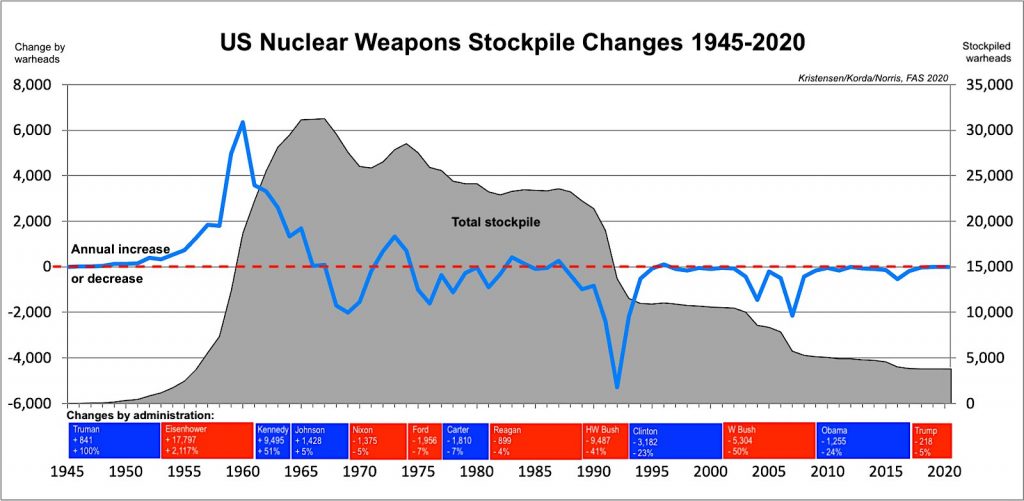
The size of the US nuclear weapons stockpile has fluctuated considerably over the years but remained relatively stable during the Trump administration. Click on image to view full size.
Implications and Recommendations
The decision by the Trump administration to deny declassification of the nuclear weapons stockpile size and dismantlement numbers contradict release of such data in the past for no apparent reason.
The increased secrecy of the US nuclear weapons arsenal comes at a time when the Trump administration has been criticizing China for “its secretive, nuclear crash buildup…” The administration’s criticism would carry a lot more weight if it didn’t hide its own stockpile behind a “great wall of secrecy.”
In addition to undercutting the US ability to push for greater transparency among other nuclear-armed states, the decision to classify warhead stockpile and dismantlement data also weakens the ability of the United States to demonstrate good faith on its efforts to continue to reduce its nuclear arsenal in the context of the upcoming review conference of the nuclear Non-Proliferation Treaty. The decision enables conspiracists to spread false rumors that the United States is secretly increasing its nuclear arsenal.
The incoming Biden administration should overturn the Trump administration’s excessive and counterproductive nuclear secrecy and restore transparency of the US nuclear warhead stockpile and dismantlement data.
Background Information:
This publication was made possible by generous contributions from the John D. and Catherine T. MacArthur Foundation, the New Land Foundation, the Ploughshares Fund, and the Prospect Hill Foundation. The statements made and views expressed are solely the responsibility of the authors.
USAF Plans To Expand Nuclear Bomber Bases
The US Air Force is working to expand the number of strategic bomber bases that can store nuclear weapons from two today to five by the 2030s.
The plan will also significantly expand the number of bomber bases that store nuclear cruise missiles from one base today to all five bombers bases by the 2030s.
The expansion is the result of a decision to replace the non-nuclear B-1B bombers at Ellsworth AFB and Dyess AFB with the nuclear B-21 over the next decade-and-a-half and to reinstate nuclear weapons storage capability at Barksdale AFB as well.
The expansion is not expected to increase the total number of nuclear weapons assigned to the bomber force, but to broaden the infrastructure to “accommodate mission growth,” Air Force Global Strike Command Commander General Timothy Ray told Congress last year.
Nuclear Bomber Base Expansion
The Air Force announced in May 2018 that the B-21 would replace the B-1B and B-2A bombers and be deployed at Ellsworth AFB, Dyess AFB, and Whiteman AFB. The commander of the strategic bomber force later explained in a video address to the B-1B bases that “the B-21 will bring significant changes to each location, to include the reintroduction of nuclear mission requirements.”
Since the B-1B was replaced in the nuclear war plan by the B-2A in 1997 and all B-1B bombers were denuclearized in 2011, the effect of the B-21 bomber program is that nuclear bomber operations will increase from the three bases today to five bases in the future (see map):
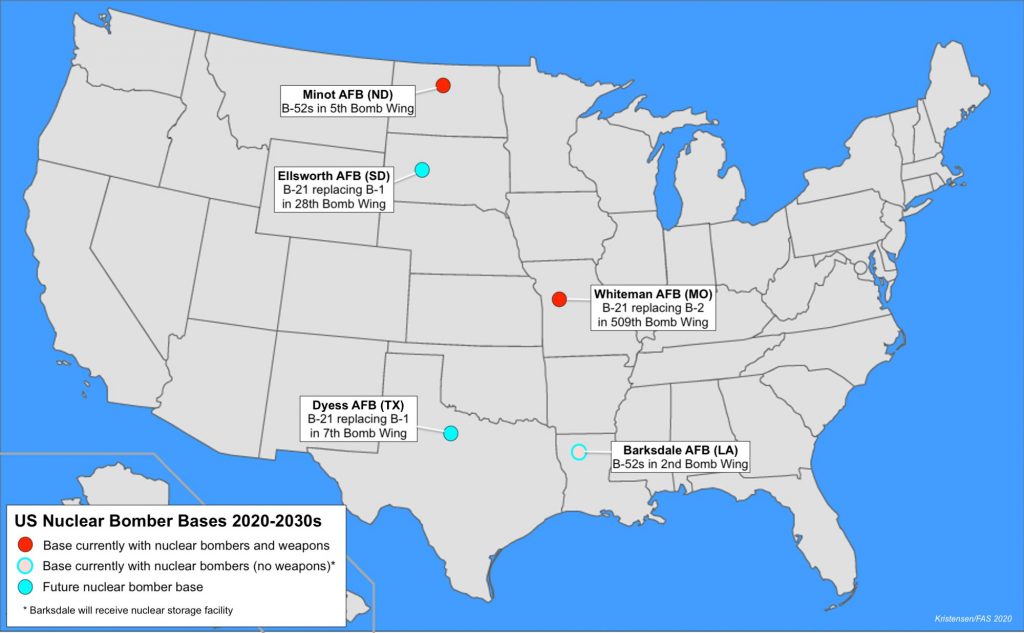
The Air Force plans to increase nuclear weapons storage capacity at bomber bases from two locations today to five in the future. Click map to view full size.
The Air Force previously planned for the B-21 to replace the B-2A no later than 2032 and the B-1Bs no later than 2036, though those dates may have shifted some since.
The effect of the integration of the B-21 is that bases with nuclear stealth bombers will increase from one today (Whiteman AFB) to three in the future.
The modernization plan also appears to significantly expand the location of nuclear cruise missiles from one base today (Minot AFB) to all five bomber bases by the late-2030s. The LRSO is scheduled to begin entering the arsenal in 2030 (see table):
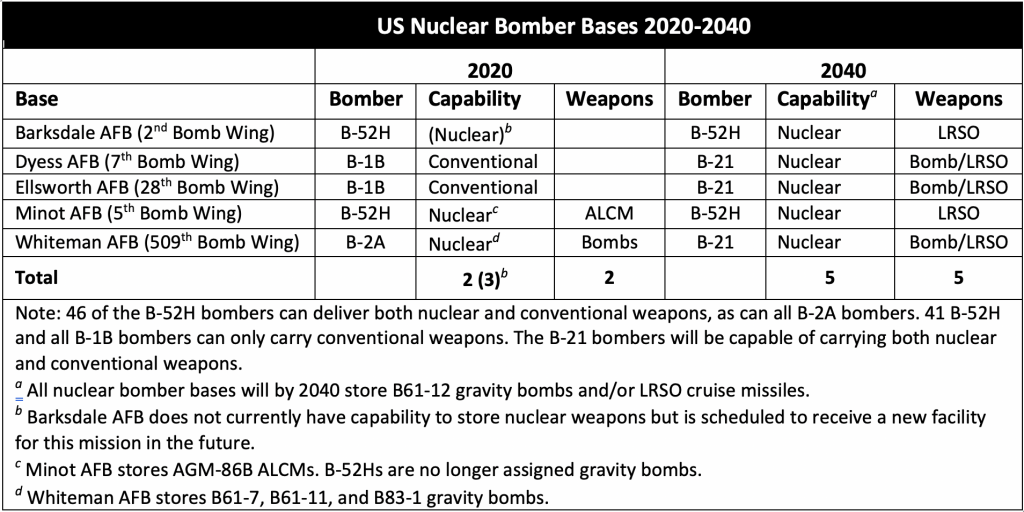
The US Air Force plans a significant expansion of nuclear bomber bases and their capabilities. Click table to view full size.
Nuclear Storage Facilities
A key element of the base upgrades to operate the B-21 involves the construction of a new nuclear weapons storage facility at each base: a Weapons Generation Facility (WGF). The new facility is different than the Weapons Storage Areas (WSAs) that that the Air Force built during the Cold War because it will integrate maintenance and storage mission sets into the same facility. The WGF will have a footprint of roughly 35 acres and include an approximately 52,000-square-foot (4,860 square meters) building as well as a 17,600 square-foot munitions maintenance building. The Air Force says the WGF will be “unique to the B-21 mission” and designed to provide a “safer and more secure location for the storage of Air Force nuclear munitions.”
An WGF is also under construction at F.E. Warren AFB for storage of ICBM warheads.
A draft Environmental Impact Statement recently posted by the Air Force shows the planned location of the nuclear weapons storage facility at Dyess and Ellsworth air force bases. At Dyess AFB, the intension is to build facility at the northern end of the base near the current munitions depot (see map below):

The Air Force plans to add nuclear weapons storage capacity to Dyess Air Force Base in Texas. Click on map to view full size.
At Ellsworth AFB, the Air Force has identified two preferred locations: one at the northern end near the munitions depot, and one at the southern end near the aircraft alert apron (see map below):

The Air Force plans to add nuclear weapons storage capacity to Ellsworth Air Force Base in South Dakota. Click on map to view full size.
Although Barksdale AFB is not scheduled to receive the B-21, preparations are underway to reinstate the capability to store nuclear weapons at the base. The capability was lost when the Air Force last decade consolidated operational nuclear ALCM storage at Minot AFB. Once completed, the new WGF will enable the base to store nuclear LRSO cruise missiles for delivery by the B-52s.
Nuclear Bomber Force Increase
The B-21 bomber program is expected to increase the overall size of the US strategic bomber force. The Air Force currently operates about 158 bombers (62 B-1B, 20 B-2A, and 76 B-52H) and has long said it plans to procure at least 100 B-21 bombers. That number now appears [https://www.airforcemag.com/article/strategy-policy-9/] to be at least 145, which will increase the overall bomber force by 62 bombers to about 220. There are currently nine bomber squadrons, a number the Air Force wants to increase to 14 (each base has more than one squadron).
During an interview with reporters in April, the head of AFGSC, General Timothy Ray, reportedly said the 220 number was a “minimum, not a ceiling” and added: “We as the Air Force now believe it’s over 220.” Whether Congress will agree to pay for that many B-21s remains to be seen.
The fielding of large numbers of nuclear-capable B-21 bombers has implications for the future development of the US nuclear arsenal. Under the New START treaty, the United States has declared it will deploy no more than 60 nuclear bombers. Although the treaty will lapse in 2026 (after a five-year maximum extension), it serves as the baseline for long-term nuclear force structure planning.
Unless the Air Force limits the number of nuclear-equipped B-21 bombers to the number of B-2As operated today, the number of nuclear bombers would begin to exceed the 60 deployed nuclear bomber pledge by 2028 (assuming an annual production of nine aircraft and two-year delay in deployment of the first nuclear unit). By 2035, the number of deployed nuclear bombers could have doubled compared with today (see graph below):
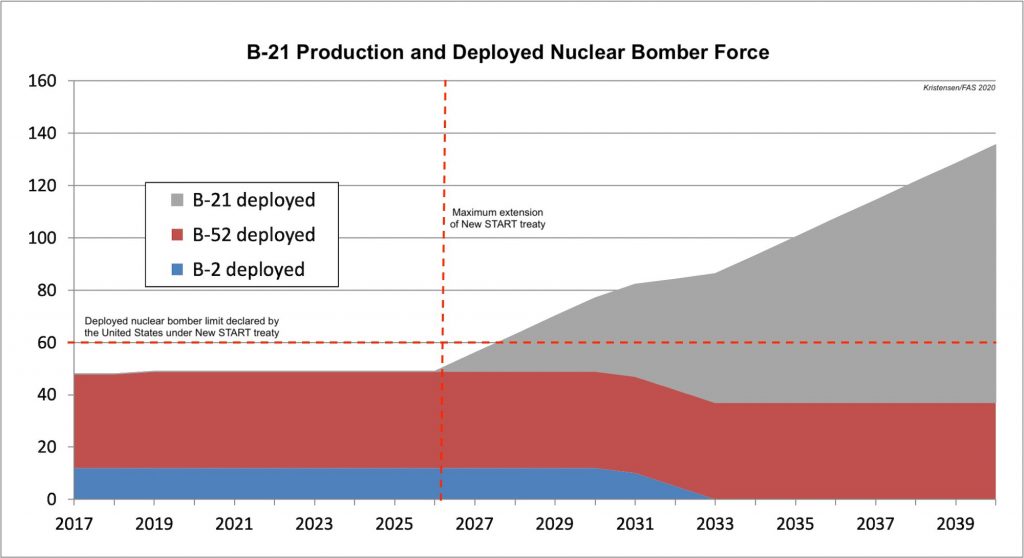
Unless nuclear B-21 bombers are not limited, the future nuclear bomber force could significantly exceed the bomber force under the current New START treaty. Click graph to view full size.
It is difficult to imagine a military justification for such an increase in the number of nuclear bombers – even without New START. One would hope that the number of nuclear B-21s will be limited to well below the total number. Although the New START treaty would have expired before this becomes a a legal issue, it would already now send the wrong message to other nuclear-armed states about US long-term intensions, deepen suspicion and “Great Power Competition,” and could complicate future arms control talks.
In the short term, the incoming Biden administration should commit the United States to not increase the number of nuclear bombers beyond those planned under the New START treaty, and it should urge Russia to make a similar declaration about the size of its nuclear bomber force.
See also: Nuclear Notebook: US nuclear force, 2020
This publication was made possible by generous contributions from the John D. and Catherine T. MacArthur Foundation, the New Land Foundation, the Ploughshares Fund, and the Prospect Hill Foundation. The statements made and views expressed are solely the responsibility of the authors.
Environmental Assessment Reveals New Details About the Air Force’s ICBM Replacement Plan
Any time a US federal agency proposes a major action that “has the potential to cause significant effects on the natural or human environment,” they must complete an Environmental Impact Statement, or EIS. An EIS typically addresses potential disruptions to water supplies, transportation, socioeconomics, geology, air quality, and other factors in great detail––meaning that one can usually learn a lot about the scale and scope of a federal program by examining its Environmental Impact Statement.
What does all this have to do with nuclear weapons, you ask?
Well, given that the Air Force’s current plan to modernize its intercontinental ballistic missile force involves upgrading hundreds of underground and aboveground facilities, it appears that these actions have been deemed sufficiently “disruptive” to trigger the production of an EIS.
To that end, the Air Force recently issued a Notice of Intent to begin the EIS process for its Ground-Based Strategic Deterrent (GBSD) program––the official name of the ICBM replacement program. Usually, this notice is coupled with the announcement of open public hearings, where locals can register questions or complaints with the scope of the program. These hearings can be influential; in the early 1980s, tremendous public opposition during the EIS hearings in Nevada and Utah ultimately contributed to the cancellation of the mobile MX missile concept. Unfortunately, in-person EIS hearings for the GBSD have been cancelled due to the ongoing Covid-19 pandemic; however, they’ve been replaced with something that might be even better.
The Air Force has substituted its in-person meetings for an uncharacteristically helpful and well-designed website––gbsdeis.com––where people can go to submit comments for EIS consideration (before November 13th!). But aside from the website being just a place for civic engagement and cute animal photos, it is also a wonderful repository for juicy––and sometimes new––details about the GBSD program itself.
The website includes detailed overviews of the GBSD-related work that will take place at the three deployment bases––F.E. Warren (located in Wyoming, but responsible for silos in Wyoming, Colorado, and Nebraska), Malmstrom (Montana), and Minot (North Dakota)––plus Hill Air Force Base in Utah (where maintenance and sustainment operations will take place), the Utah Test and Training Range (where missile storage, decommissioning, and disposal activities will take place), Camp Navajo in Arizona (where rocket boosters and motors will be stored), and Camp Guernsey in Wyoming (where additional training operations will take place).
Taking a closer look at these overviews offers some expanded details about where, when, and for how long GBSD-related construction will be taking place at each location.
For example, previous reporting seemed to indicate that all 450 Minuteman Launch Facilities (which contain the silos themselves) and “up to 45” Missile Alert Facilities (each of which consists of a buried and hardened Launch Control Center and associated above- or below-ground support buildings) would need to be upgraded to accommodate the GBSD. However, the GBSD EIS documents now seem to indicate that while all 450 Launch Facilities will be upgraded as expected, only eight of the 15 Missile Alert Facilities (MAF) per missile field would be “made like new,” while the remainder would be “dismantled and the real property would be disposed of.”
Currently, each Missile Alert Facility is responsible for a group of 10 Launch Facilities; however, the decision to only upgrade eight MAFs per wing––while dismantling the rest––could indicate that each MAF could be responsible for up to 18 or 19 separate Launch Facilities once GBSD becomes operational. If this is true, then this near-doubling of each MAF’s responsibilities could have implications for the future vulnerability of the ICBM force’s command and control systems.
The GBSD EIS website also offers a prospective construction timeline for these proposed upgrades. The website notes that it will take seven months to modernize each Launch Facility, and 12 months to modernize each Missile Alert Facility. Once construction begins, which could be as early as 2023, the Air Force has a very tight schedule in order to fully deploy the GBSD by 2036: they have to finish converting one Launch Facility per week for nine years. It is expected that construction and deployment will begin at F.E. Warren between 2023 and 2031, followed by Malmstrom between 2025 and 2033, and finally Minot between 2027 and 2036.
Although it is still unclear exactly what the new Missile Alert Facilities and Launch Facilities will look like, the EIS documents helpfully offer some glimpses of the GBSD-related construction that will take place at each of the three Air Force bases over the coming years.
In addition to the temporary workforce housing camps and construction staging areas that will be established for each missile wing, each base is expected to receive several new training, storage, and maintenance facilities. With a single exception––the construction of a new reentry system and reentry vehicle maintenance facility at Minot––all of the new facilities will be built outside of the existing Weapons Storage Areas, likely because these areas are expected to be replaced as well. As we reported in September, construction has already begun at F.E. Warren on a new underground Weapons Generation Facility to replace the existing Weapons Storage Area, and it is expected that similar upgrades are planned for the other ICBM bases.
Finally, the EIS documents also provide an overview of how and where Minuteman III disposal activities will take place. Upon removal from their silos, the Minutemen IIIs will be transported to their respective hosting bases––F.E. Warren, Malmstrom, or Minot––for temporary storage. They will then be transported to Hill Air Force Base, the Utah Test and Training Range (UTTR), or Camp Najavo, in Arizona. It is expected that the majority of the rocket motors will be stored at either Hill AFB or UTTR until their eventual destruction at UTTR, while non-motor components will be demilitarized and disposed of at Hill AFB. To that end, five new storage igloos and 11 new storage igloos will be constructed at Hill AFB and UTTR, respectively. If any rocket motors are stored at Camp Navajo, they will utilize existing storage facilities.
After the completion of public scoping on November 13th (during which anyone can submit comments to the Air Force via Google Form), the next public milestone for the GBSD’s EIS process will occur in spring 2022, when the Air Force will solicit public comments for their Draft EIS. When that draft is released, we should learn even more about the GBSD program, and particularly about how it impacts––and is impacted by––the surrounding environment. These particular aspects of the program are growing in significance, as it is becoming increasingly clear that the US nuclear deterrent––and particularly the ICBM fleet deployed across the Midwest––is uniquely vulnerable to climate catastrophe. Given that the GBSD program is expected to cost nearly $264 billion through 2075, Congress should reconsider whether it is an appropriate use of public funds to recapitalize on elements of the US nuclear arsenal that could ultimately be rendered ineffective by climate change.
Additional background information:
- United States nuclear forces, 2020
-
Construction of New Underground Nuclear Warhead Facility At Warren AFB
This publication was made possible by generous contributions from the Carnegie Corporation of New York, the John D. and Catherine T. MacArthur Foundation, the New Land Foundation, the Ploughshares Fund, and the Prospect Hill Foundation. The statements made and views expressed are solely the responsibility of the author.
Image sources: Air Force Global Strike Command. 2020. “Environmental Impact Statement for the Ground-Based Strategic Deterrent Deployment and Minuteman III Decommissioning and Disposal: Public Scoping Materials.”
US Officials Give Confusing Comparisons Of US And Russian Nuclear Forces
October 22, 2020 [updated]
In their effort to paint the New START treaty as insufficient and a bad deal for the United States and its allies, Trump administration official have recently made statements suggesting the treaty limits the US nuclear arsenal more than it limits the Russian arsenal.
New START imposes the same restrictions on US and Russian strategic nuclear forces.
During a virtual conference organized by the Heritage Foundation on October 13, Marshall Billingslea, special presidential envoy for arms control, stated: “What we’ve indicated to the Russians is that we are in fact willing to extend the New START Treaty for some period of time provided that they agree to a limitation, a freeze, in their nuclear arsenal. We’re willing to do the same. I don’t see how it’s in anyone’s interests to allow Russia to build up its inventory of these tactical nuclear weapons systems with which they like to threaten NATO…We cannot agree to a construct that leaves unaddressed 55 percent or more of the Russian arsenal.”
One week later, in an interview on National Public Radio, Billingslea added: “The New START treaty constraints…92 percent of the entire U.S. arsenal, of our deterrent” but “only covers 45 percent or less of the Russian arsenal…”
Finally, on October 21, Secretary of State Michal Pompeo repeated this talking point: “President Trump has made clear that the New START Treaty by itself is not a good deal for the United States or our friends or allies. Only 45 percent of Russia’s nuclear arsenal is subject to numerical limits, posing a threat to the United States and our NATO allies. Meanwhile, that agreement restricts 92 percent of America’s arsenal that is subject to the limits contained in the New START agreement.”
Pompeo and Billingslea didn’t specify what they meant by “arsenal” and the reaction from nuclear weapons analysts – ourselves included – was bewilderment. Most assumed “arsenal” was referring warheads, but the numbers don’t seem to fit with the percentages and descriptions in the statements. Interestingly, the percentages and categories seem to work better for launchers, unless one does a back-of-the-envelope calculation.
Matching Comparison With Warheads
Our first step was to analyze the statements and see if we could make them fit with our understanding of the size and composition of the nuclear arsenals. If we assume the percentages and descriptions refer to warhead numbers, then we see the following potential options:
Option 1: The 45% refers to New START warhead limit for deployed strategic warheads (1,550). If this were the case, then Russia’s entire stockpile would only consist of 3,445 warheads, which we doubt. Our estimate is 4,310. For the United States, 1,550 would only constitute 41% of the US stockpile, not 92% as stated by Billingslea.
Option 2: The 45% refers to the number of strategic warheads that can be loaded onto ICBMs and SLBMs but not bomber weapons. New START counts actual numbers of warheads on deployed ICBMs and SLBMs, but not those on bomber bases. According to our estimate of Russian forces, their ICBMs can load 1,136 warheads and SLBMs can load 720 warheads, a total of 1,856 warheads. That would constitute 43% of the total stockpile of 4,310 warheads (our estimate). It would of course be embarrassing if the US officials have been using our numbers instead of those of the US Intelligence Community. Even so, that methodology does not fit with the 92% comparison used for the United States. US ICBMs and SLBMs can load a maximum of 2,720 warheads, by our estimate, or 72% of the stockpile. And Billingslea explicitly says the US comparison includes the “entire” arsenal.
Option 3: The 45% refers to the total number of strategic warheads in the Russian arsenal (deployed and non-deployed). If that were the case, then the remaining 55% of 3,025 warheads would be non-strategic warheads, far more than the “up to 2,000” stated in the Nuclear Posture Review. And it would imply a total stockpile of 5,500 warheads, far more than the number of warhead spaces on launchers.
Option 4: The percentage numbers come from a simplistic back-of-the-envelope calculation. The Russian 45% is 1,550 (New START limit) / 1,550 (reserve) + 2,000 (tactical). The US 92% is 1,550 (New START limit) / 1,550 (reserve) + 150 (tactical). Those numbers don’t fully match the stockpiles and statements but can explain the comparison. (We are indebted to Pavel Podvig for suggesting this option.)
Billingslea and Pompeo both compared the Russian restrictions to those affecting the US arsenal, but they described it differently.
Billingslea said New START “constraints…92 percent of the entire U.S. arsenal, of our deterrent…” (emphasis added). Since we know the approximate size of the total US stockpile (about 3,800 warheads), 92% would constitute 3,496 warheads, far more than the treaty’s limit of 1,550 deployed strategic warheads. But the count would be close to the number of strategic warheads that can be loaded onto strategic launchers (3,570 by our estimate), leaving about 300 non-strategic warheads.
Pompeo said that New START “restricts 92 percent of America’s arsenal that is subject to the limits” (emphasis added), which is different than what Billingslea said because it doesn’t appear to include non-deployed strategic warheads or tactical warheads, two categories that are not subject to the treaty limits.
Matching Comparison With Launchers
Our next step was to analyze the statements to see how they compare with the number of launchers that can deliver nuclear warheads. New START limits both sides to no more than 800 strategic launchers in total, of which no more than 700 can be deployed at any given time.
In the latest set of aggregate numbers released by the US State Department, the United States is listed with exactly 800 launchers in total, of which 675 are deployed. Russia is listed with a total of 764 launchers, of which 510 are deployed.
While complaining about limits on US and Russian weapons, neither Billingslea nor Pompeo mentions this US strategic advantage of 165 deployed launchers, a number that exceeds the number of Minuteman IIIs in one missile wing and corresponds to more than half of the entire Russian ICBM force.
For the United States, if the 800 total strategic launchers constitute 92% of all US nuclear launchers (“entire” arsenal), then that would imply the existence of another 70 launchers, which potentially could refer to non-strategic fighter-bombers assigned missions with gravity bombs.
For Russia, if the 764 total strategic launchers constitute 45% of all its nuclear launchers, that would potentially imply that Russia has 1,698 total nuclear launchers, of which 934 would be launchers of non-strategic nuclear weapons.
We don’t yet know if this is the case. But the percentages mentioned by Billingslea and Pompeo appear to fit better if they refer to launchers than warheads, unless one applies the Option 4 calculation described above. The Trump administration has been particularly critical about Russia’s development of new types of strategic-range weapons that are not covered by the New START treaty, just like it has criticized that Russia’s non-strategic nuclear weapons are not covered by any arms control agreement.
Context and Recommendations
The comparisons and descriptions of Russian and US nuclear forces presented by Billingslea and Pompeo are confusing. Some might suspect “fuzzy math” but until we see otherwise, we suspect the comparisons use real data. Option 4 above might represent the most likely explanation although it doesn’t fully match the stockpiles and descriptions provided by the officials.
When it comes to nuclear negotiations, it is incredibly important to be precise with official words and statements, in order to avoid misunderstandings or mischaracterizations. Unfortunately, the Trump administration has a habit of cherry-picking or spinning statistics in an apparent attempt to make existing and equitable arms control agreements seem like “bad deals” for the United States. Given this track record, we should view their statements here with skepticism and ask for clarification if they’re referring to warheads or launchers. We have done so but have not yet heard back from the State Department.
A one-year extension of New START is better than no extension, but it’s worse than a five-year extension because it creates uncertainty about the commitment to continue to limit force levels and unnecessarily shortens the time available to negotiate follow-on arrangements. There is no technical need to shorten the extension. If a new deal is made, the old one will fall away.
A freeze on warheads would be a welcoming new step and Russia’s acceptance of the idea is a breakthrough because it opens up possibilities for building on this idea in the future. But a freeze will not have much credibility or effect without verification and despite saying it would like “portal monitoring” the Trump administration has not presented a plan for how this would work or secured Moscow’s agreement. Verification of a total warhead freeze would be much more complex than verifying the New START treaty itself and one year may not be sufficient to do the work. Has the US military and intelligence community signed off on Russian inspectors monitoring every US warhead moving in and out of facilities? Have US allies in Europe agreed to allow Russian officials to monitor the bases where the US Air Force stores nuclear bombs?
Russia’s acceptance of a one-year New START extension and a declaration to freeze warhead levels is a significant compromise from its previous offer to unconditionally extend the treaty by five years with no warhead freeze.
The Trump administration’s “offer” of a one-year extension of New START and a one-year warhead freeze with no verification at the outset represents an astounding walk-back from its previous statements. Trump has repeatedly called New START a “bad deal” and the whole point of the talks was to “fix” what the administration claimed was inadequate verification, incorporate Russia’s new strategic weapons into the agreement, and get China onboard. And how many times have we heard that you can’t trust Russia because they violate every arms control agreement they have signed? Yet here we are. None of those “fixes” are attached to the one-year treaty extension and the administration now says it is willing to sign on to a warhead freeze without agreed verification measures with the Great Cheater.
There is nothing wrong with trying to broaden arms control to other weapons categories and countries. We strongly support that. But the last-minute flurry and attempts to shorten extension strongly suggest that the Trump administration has been more focused on creating chaos and to appear tough on Moscow and Beijing than to create nuclear arms control progress. The one-year timeline unnecessarily constrains both countries and could well mean that they would be in pretty much the same situation one year from now.
The inconvenient fact is that New START is working as designed and keeps the vast majority of Russian and US strategic arsenals in check, prevents either country from uploading thousands of extra warheads onto their deployed missiles, and offers a modicum of predictability in an otherwise unpredictable world.
Additional background information:
- Status of world nuclear forces, September 2020
- United States nuclear forces, 2020
- Russian nuclear forces, 2020
- At 11th Hour, New START Data Reaffirms Importance of Extending Treaty
This publication was made possible by generous contributions from the Carnegie Corporation of New York, the John D. and Catherine T. MacArthur Foundation, the New Land Foundation, the Ploughshares Fund, and the Prospect Hill Foundation. The statements made and views expressed are solely the responsibility of the authors.
At 11th Hour, New START Data Reaffirms Importance of Extending Treaty
Just four months before the New START treaty is set to expire, the latest set of so-called aggregate data published by the State Department shows the treaty is working and that both countries – despite tense military and political rhetoric – are keeping their vast strategic nuclear arsenals within the limits of the treaty.
The treaty caps the number of long-range strategic missiles and heavy bombers the two countries can possess to 800, with no more than 700 launchers and 1,550 warheads deployed. The treaty entered into force in February 2011, into effect in February 2018, and is set to expire on February 5, 2021 – unless the two countries agree to extend it for an additional five years.
Twice a year, the two countries have exchanged detailed data on their strategic forces. Of that data, the public gets to see three sets of numbers twice a year (1 March and 1 October): the aggregate data of deployed launchers, warheads attributed to those launchers, and total launchers. This time, the web-version helpfully includes the full data set (including a breakdown of US forces; it would be helpful is Moscow could also publish its breakdown) but the PDF-version does not.
This is the final set of periodic six-month aggregate data to be released, although a final set will probably be released if the treaty expires in February. If the treaty is extended for another five years, an additional ten data sets would probably be released.
The nearly ten years of aggregate data published so far looks like this:
Combined Forces
The latest set of this data shows the situation as of October 1, 2020. As of that date, the two countries possessed a combined total of 1,564 accountable strategic missiles and heavy bombers, of which 1,185 launchers were deployed with 2,904 warheads. That is a slight increase in the number of deployed launchers and warheads compared with six months ago (note: the combined warhead number is actually about 100 too high because each deployed bomber is counted as one weapon even though neither country’s bombers carry weapons under normal circumstances).
Compared with March 2020, the data shows the two countries combined increased the total number of strategic launchers by 10, increased combined deployed strategic launchers by 45, and increased the combined deployed strategic warheads by 205. Of these numbers, only the “10” is real; the other changes reflect natural fluctuations as launchers move in and out of maintenance or are being upgraded.
In terms of the total effect of the treaty, the data shows the two countries since February 2011 have cut 425 strategic launchers from their combined arsenals, reduced deployed strategic launchers by 218, and reduced the number of deployed strategic warheads by 433. However, it is important to remind that this warhead reduction is but a fraction (less than 6 percent) of the estimated 8,110 warheads that remain in the two countries combined nuclear weapons stockpiles (less than 4 percent if counting their total combined inventories of 12,170 stockpiled and retired (but yet to be dismantled) warheads).
The United States
The data shows the United States currently possessing 800 strategic launchers, the maximum number allowed by the treaty, of which 675 are deployed with 1,457 warheads attributed to them. This is an increase of 20 deployed strategic launchers and 84 deployed strategic warheads over the past 6 months. These are not actual increases but reflect normal fluctuations caused by launchers moving in and out of maintenance. The United States has not reduced its total inventory of strategic launchers since 2017.
The warhead numbers are interesting because they reveal that the United States now deploys 1,009 warheads on the 220 deployed Trident missiles on the SSBN fleet. That’s an increase of 82 warheads compared with March and the first time since 2015 that the United States has deployed more than 1,000 warheads on its submarines, or an average of 4-5 warheads per deployed missile. Overall, this accounts for nearly 70 percent of all the 1,457 warheads attributed to the deployed strategic launchers (nearly 72 percent if excluding the “fake” 50 bomber weapons included in the official count).
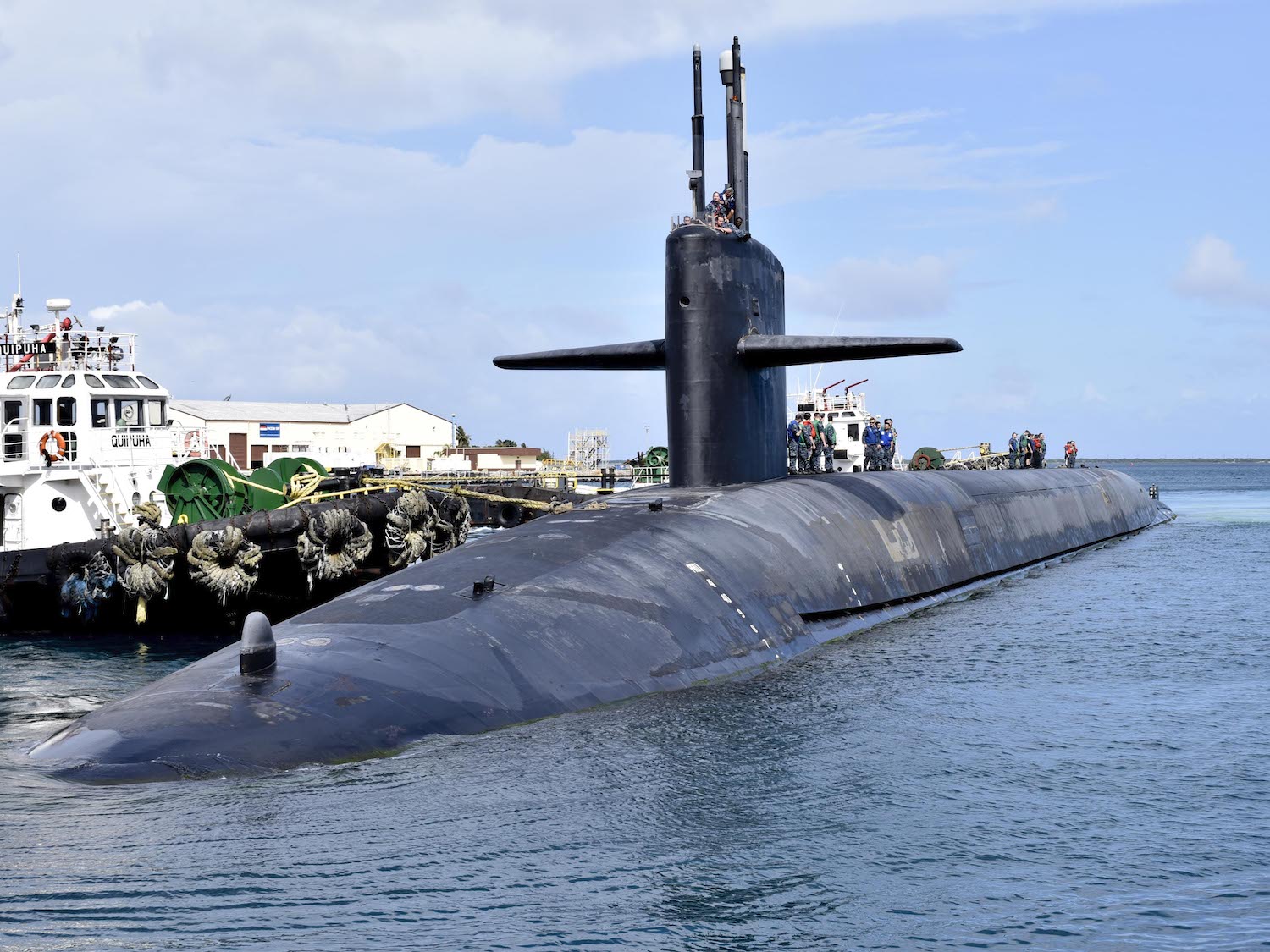
The New START data reveals that the United States as of October 1, 2020 deployed over 1,000 warheads on its fleet of ballistic missile submarines.
Compared with February 2011, the United States has reduced its inventory of strategic launchers by 324, deployed launchers by 207, and deployed strategic warheads by 343. While important, the warhead reduction represents only a small fraction (about 9 percent) of the 3,800 warheads that remain in the U.S. stockpile (less than 6 percent if counting total inventory of 5,800 stockpiled and retired (but yet to be dismantled) warheads).
The Russian Federation
The New START data shows Russia with an inventory of 764 strategic launchers, of which 510 are deployed with 1,447 warheads attributed to them. Compared with six months ago, this is an increase of 25 deployed launchers and 121 deployed strategic warheads. The change reflects fluctuations caused by launcher maintenance and upgrade work to new systems.
Compared with February 2011, Russia has cut its inventory of strategic launchers by 101, deployed launchers by 11, and deployed strategic warheads by 90. This modest warhead reduction represents about 2 percent of the estimated 4,310 warheads that remain in Russia’s nuclear weapons stockpile (not even 3 percent if counting the total inventory of 6,370 stockpiled and retired (but yet to be dismantled) Russian warheads).
Compared with 2011, the Russian reductions accomplished under New START are smaller than the U.S. reductions because Russia had fewer strategic forces than the United States when the treaty entered into force in 2011.
Build-up, What Build-up?
With frequent claims by U.S. officials and nuclear weapons advocates that Russia is increasing its nuclear arsenal, it is interesting that despite a significant modernization program, the New START data shows this increase is not happening in the size of Russia’s accountable strategic nuclear forces. (The number of strategic-range nuclear forces outside New START is minuscule.)
On the contrary, the New START data shows that Russia has 165 deployed strategic launchers less than the United States, a significant gap that exceeds the size of an entire US Air Force ICBM wing. It is significant that Russia despite its modernization programs has not sought to reduce this gap by deploying more strategic launchers. Instead, the Russian launcher deficit has been increasing by one-third since its lowest point in February 2018. One factor that could change this is if the Trump administration kills New START and Russia believes the threat made by Marshall Billingslea, the Trump administration’s Special Presidential Envoy for Arms Control, that the United States might increase its nuclear forces if New START expires.
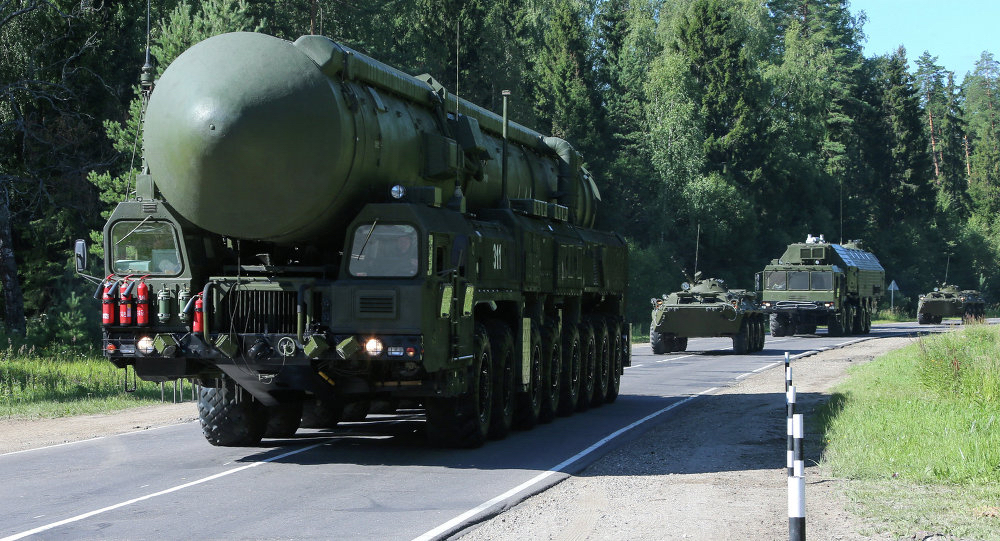
The New START data shows that Russia’s nuclear modernization program has not been trying increase the number of launchers despite a sizable gap compared with the US arsenal.
Instead, the Russian military appears to try to compensate for the launcher gap by increasing the number of warheads that can be carried on the newer missiles that are replacing older types (Yars and Bulava). Many of these warheads are not deployed on the missiles under normal circumstance, however, but stored and could potentially be uploaded onto launchers in a crisis. The United States also has such an upload capability for its larger inventory of launchers and therefore is not at a strategic disadvantage.
Two of Russia’s new strategic nuclear weapons (Avangard and Sarmat) are covered by New START if formally incorporated. Other types, which have become a sticking point for the Trump administration, are in relatively small numbers (if they have even been deployed yet) and do not appear capable of upsetting the strategic balance in the foreseeable future. The treaty includes provisions for including new weapon types.
Inspections and Notifications
In addition to the New START data, the U.S. State Department has also updated the overview of part of its treaty verification activities. The data shows that the two sides since February 2011 have carried out 328 on-site inspections of each other’s strategic nuclear forces and exchanged 20,871 notifications of launcher movements and activities. Nearly 1,200 of those notifications were exchanged since March 5, 2020.
Importantly, due to the Coronavirus outbreak, there have been no on-site inspections conducted since April 1, 2020. Treaty opponents might use this to argue that compliance with the treaty cannot be determined or that it shows it’s irrelevant. Both claims would be wrong because National Technical Means of verification also provide insight to activities on the ground, but that on-site inspections provide valuable additional data.
This inspection and notification regime and record are crucial parts of the treaty and increasingly important for US-Russian strategic relations as other treaties and agreements have been scuttled.
The 11th Hour
Time is now quickly running out for New START with only a little over four months remaining before the treaty expires on February 5, 2021. Rather than working to secure extension, the Trump administration instead has introduced last-minute conditions that threaten to derail extension.
Russia and the United States can and should extend the New START treaty as is by up to 5 more years. Once that is done, they should continue negotiations on a follow-on treaty with additional limitations and improved verification. It is essential both sides act responsibly and do so to preserve this essential cornerstone of strategic stability.
The fact that Marshall Billingslea has already threatened to increase US nuclear forces if Russia doesn’t agree to the US conditions for extending the treaty only reaffirms how important New START is for keeping a lid on US and Russian strategic nuclear forces and for providing transparency and predictability on the status and plans for the arsenals.
Additional background information:
Status of world nuclear forces, September 2020
This publication was made possible by generous contributions from the John D. and Catherine T. MacArthur Foundation, the New Land Foundation, the Ploughshares Fund, and the Prospect Hill Foundation. The statements made and views expressed are solely the responsibility of the authors.
Remembering Hiroshima and Nagasaki, 75 Years After
Seventy-five years ago, the United States conducted two nuclear attacks against the cities of Hiroshima and Nagasaki, Japan, devastating their populations and destroying their infrastructure.
In the process of manufacturing and testing the nuclear weapons that would eventually be used on Hiroshima and Nagasaki, civilians within downwind communities, nuclear workers, uranium miners and their families, and military personnel were also exposed to harmful and sometimes deadly levels of ionizing radiation. Following their use in Japan, the production and past testing of nuclear weapons in the United States and internationally continues to harm the health, environment, and cultures of communities around the world.
In the United States, we are commonly told that creating and dropping these nuclear bombs was “necessary” in order to end the Second World War and save additional lives. As several prominent historians have detailed extensively, this narrative is oversimplistic and ahistorical: the bombs were never intended to take the place of an invasion, and it is not even clear that they directly brought about the end of the war in the way that is often portrayed. Primary documents show that the commonly-taught narrative about the two atomic bombings can be easily deconstructed. Additionally, these nuclear bombings followed devastating conventional firebombings of Japanese cities that were specifically designed to target civilians and infrastructure.
Seventy-five years later, we commemorate the nuclear attacks and the unspeakable human suffering they inflicted, which remind us of the uniquely destructive capability of nuclear weapons and the importance of ensuring that they are never used in anger again.
In recognition of this 75th anniversary, the Federation of American Scientists is honored to join a coalition of nuclear weapons organizations and survivors in calling for our leaders to take the actions necessary to ensure nuclear weapons are never used again and to negotiate in good faith the global elimination of these most devastating weapons of mass destruction.
As our coalition statement reads,
Today, we are living in a time of extraordinary nuclear dangers. Vital international agreements to reduce and control nuclear weapons worldwide are being abandoned. Budgets for the development and production of new nuclear weapons are growing. Tensions among nuclear-armed nations are rising to levels not seen since the Cold War.
As the mayors of Hiroshima and Nagasaki warn: “We are badly off course in efforts to honor the plea of the hibakusha and end the nuclear threat.”
As the only country to use nuclear weapons in conflict, the United States has a moral obligation to lead the world in ending this menace and restoring communities impacted by nuclear weapons.
People created these weapons and designed the systems governing their use; people can work to eliminate them.
As we wrote on the 75th anniversary of the Trinity test, we are trending in the wrong direction. Despite reductions since the Cold War, there are still more than 13,000 nuclear weapons in the world, and every nuclear-armed country is currently in the midst of modernizing their nuclear arsenals. Disturbingly, bilateral and multilateral arms control agreements have fallen away or are currently under severe stress. Most immediately concerning is New START, which effectively limits US and Russian strategic warhead and launcher deployments, but expires in February 2021. As we have written, New START extension is a no-brainer: Russia and the United States can extend the New START treaty by up to 5 more years. It is essential both sides act responsibly and do so to preserve this essential agreement.
The Federation of American Scientists is honored to provide the world with the best non-classified estimates of the nuclear weapons arsenals. We are grateful for the financial support from the New Land Foundation, MacArthur Foundation, Ploughshares Fund, and the Prospect Hill Foundation to do this work. To explore this vast data, developed over many decades, start here.

